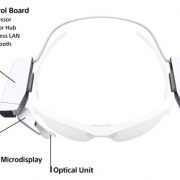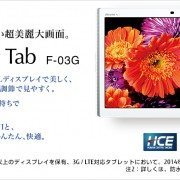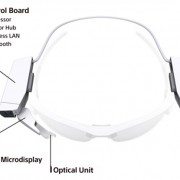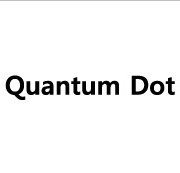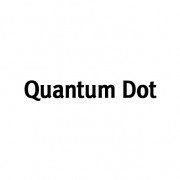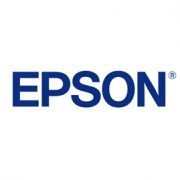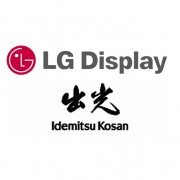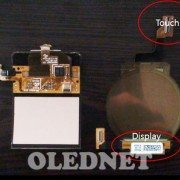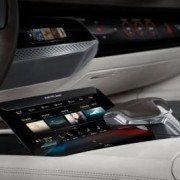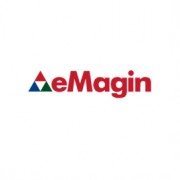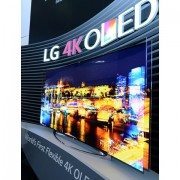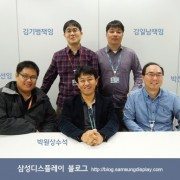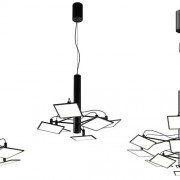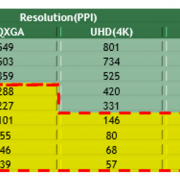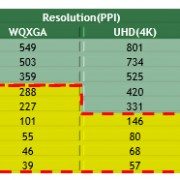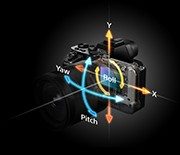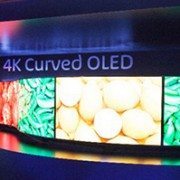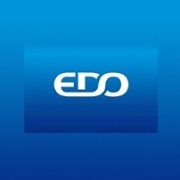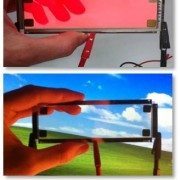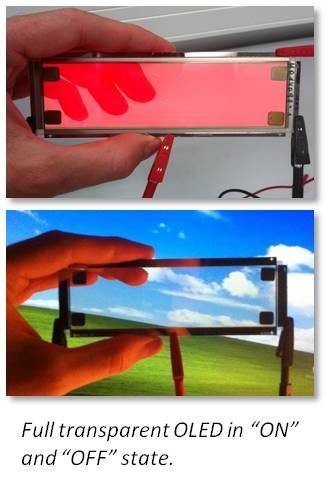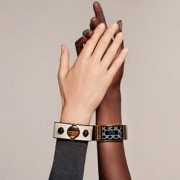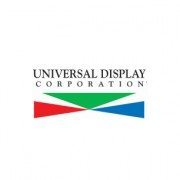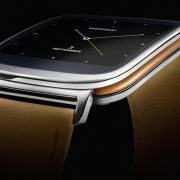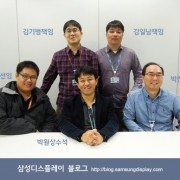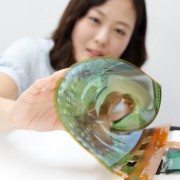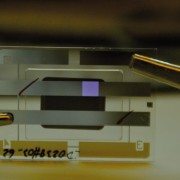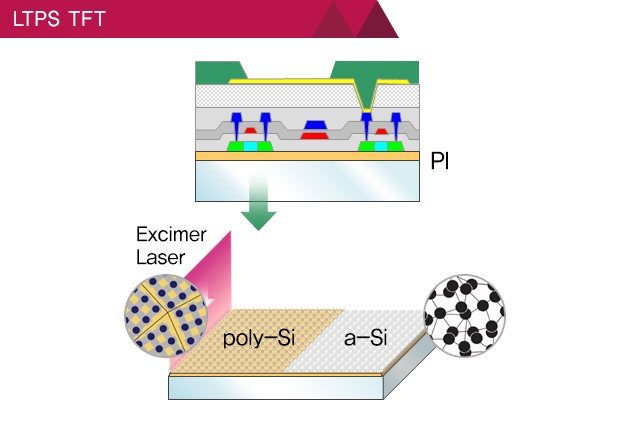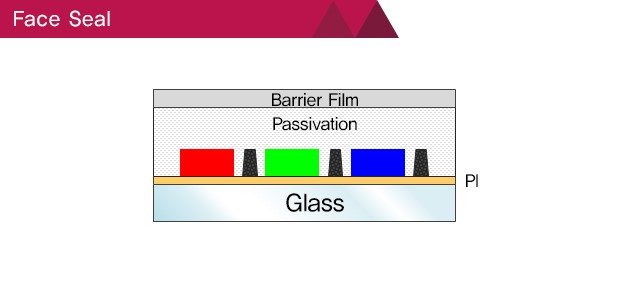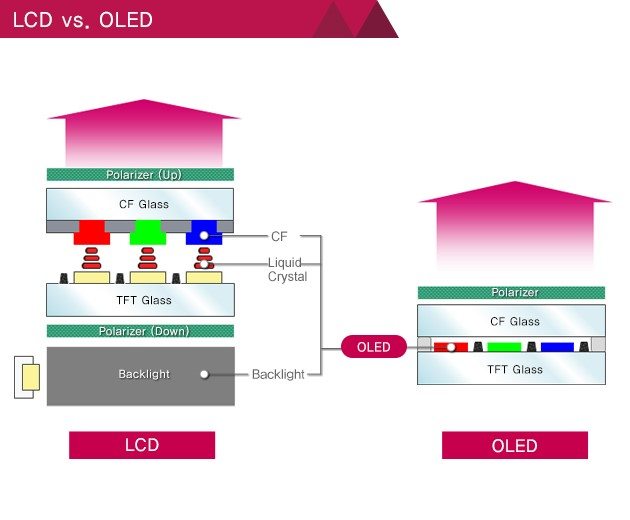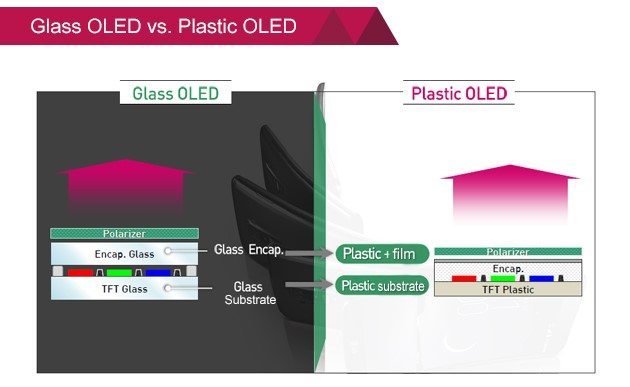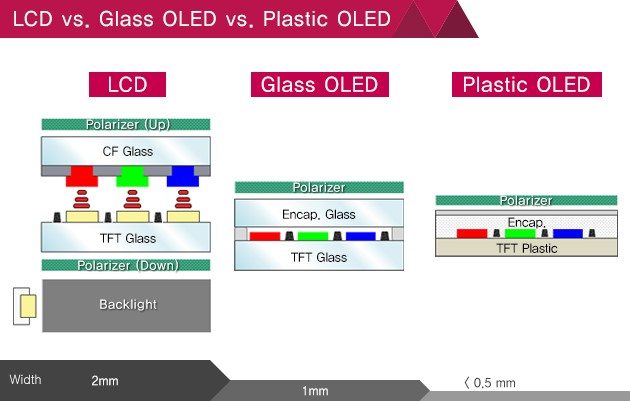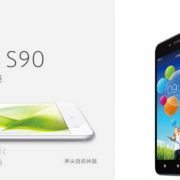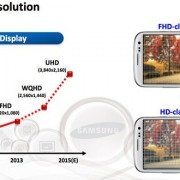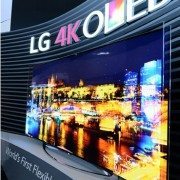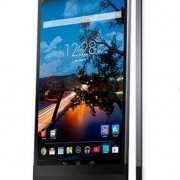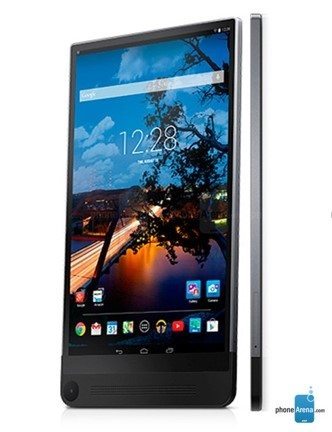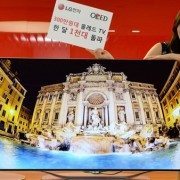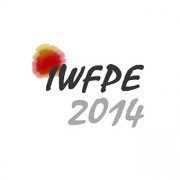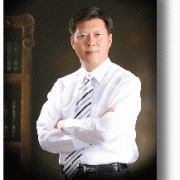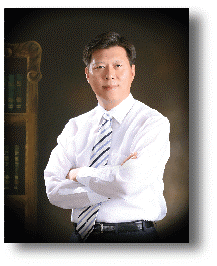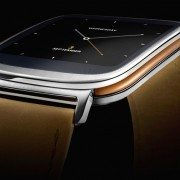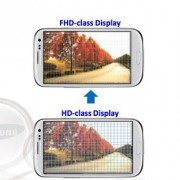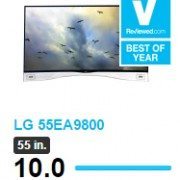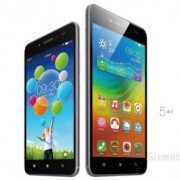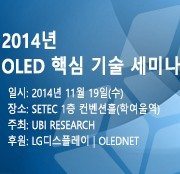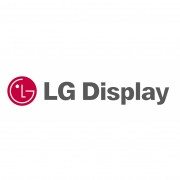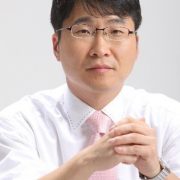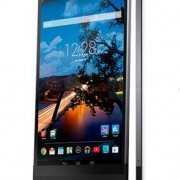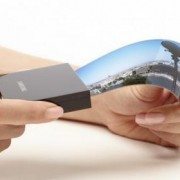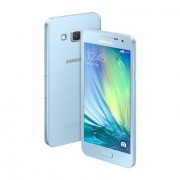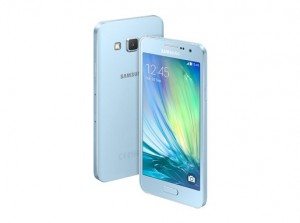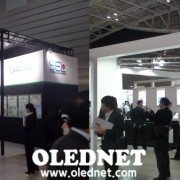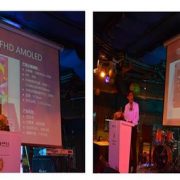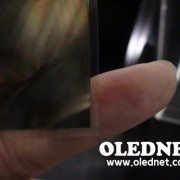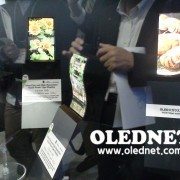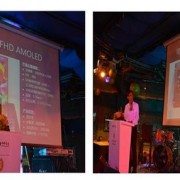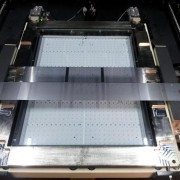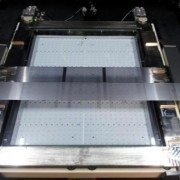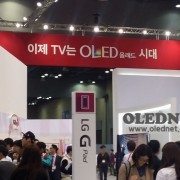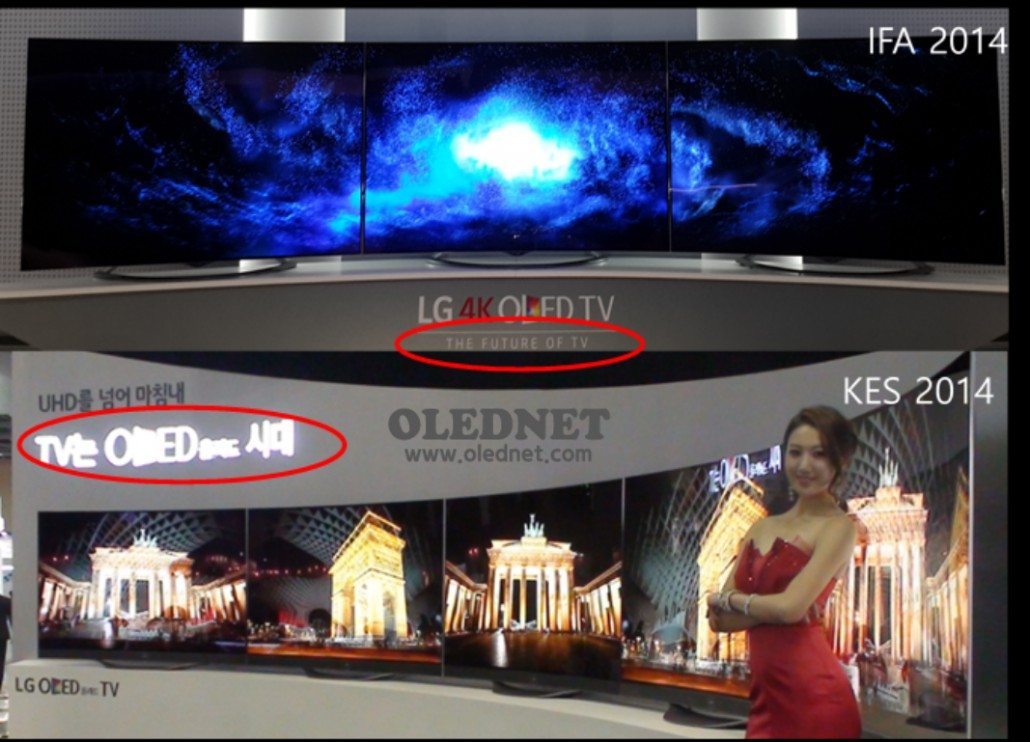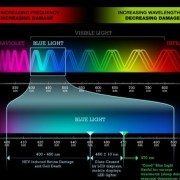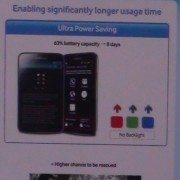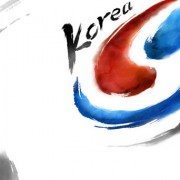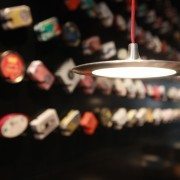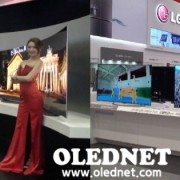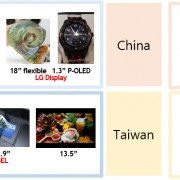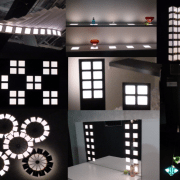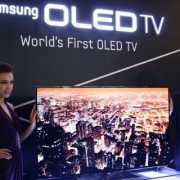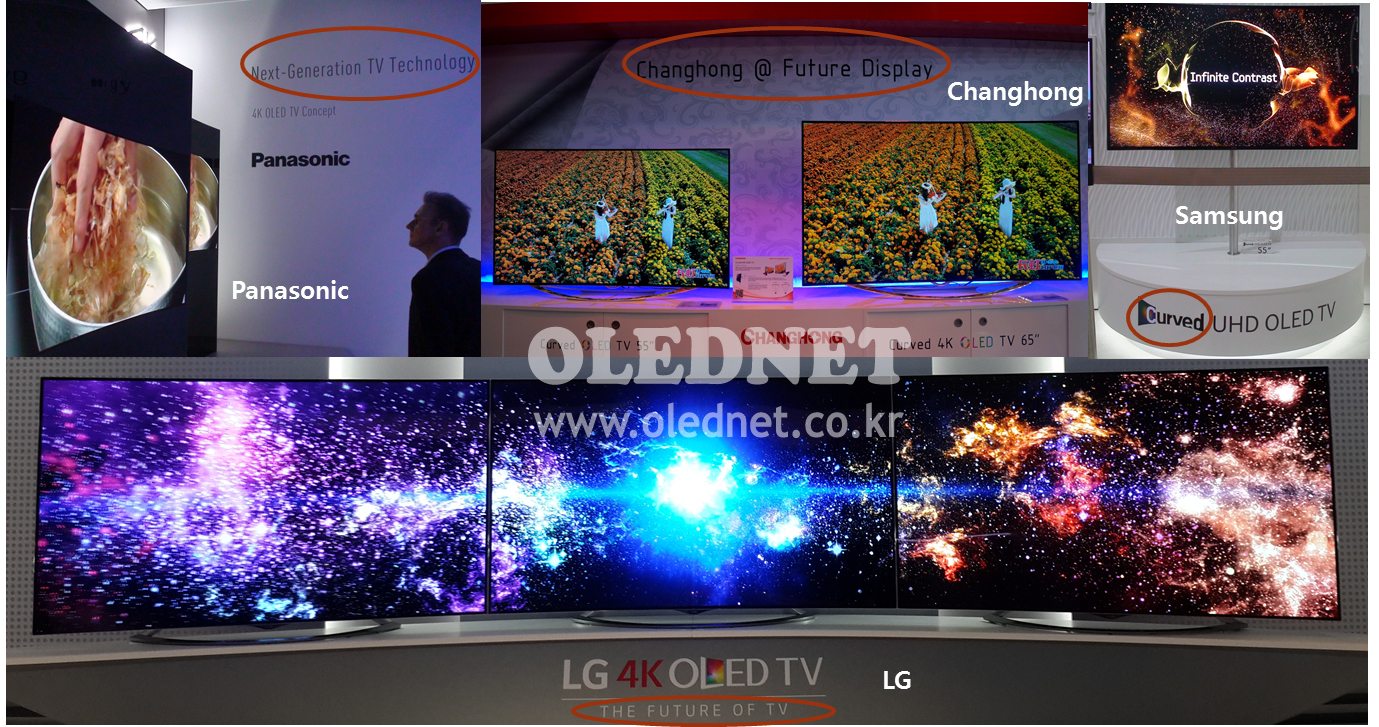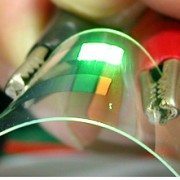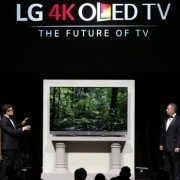Gear S 분해 광학필름 분리 제거
/0 코멘트/카테고리: OLED 비디오 /작성자: oledSony, unveiled a high-resolution single-lens OLED module
/0 코멘트/카테고리: /작성자: OLEDNETSony developed a glasses-style smart device of a single-lens display module.
<Single-lens display module>
Source: Sony
<(top) sample field of vision, (bottom) module attached to eyewear piece>
Source: Sony
This module was designed by Sony to be a small and light weight glasses-style composed of OLED microdisplay, micro-optical unit, and miniaturized control board.
It is the smallest display module as a 0.23-inch high-resolution (640×480) OLED microdisplay. The contrast ratio is over 10,000:1 with 100% sRGB. Generally the RGB stripe is used to secure the color purity, but this panel uses the optimized matrix configuration.
<Display arm of the module>
Source: Sony
Samsung Display, to break through crisis with diversification of OLED customer!
/0 코멘트/카테고리: /작성자: OLEDNETSamsung Display is speeding up to be post-Samsung Electronics. The world’s sole OLED panel that Samsung Display manufactures is applied to most of the products by Samsung Electronics’ IM Division. Samsung Display expected to expand the OLED panel market as building the A2 line additionally in 2013 but the Smartphone Galaxy S5 did not measure up to the expectations resulting gradual decrease of factory operation rate a long with the sales. The diversification of customers is required at this moment in the Samsung Display’s AMOLED panel industry which heavily relies on Samsung Electronics. And the result of those efforts begins to appear in the tablet PC area. In the last month, Dell revealed the tablet PC Venue 8 7000 using the Samsung Display’s 8-inch AMOLED panel (refer to the OLEDNET article posted on November 4), and now Fujitu released the tablet PC ARROW Tab F-03G with 10.5-inch AMOLED panel. (http://www.fmworld.net/product/phone/f-03g/info.html#heading02). Fujitsu is emphasizing the excellent picture quality of the tablet PC with AMOLED panel compared to the product made of LCD. It has been only half a year since the OLED was applied to the tablet PC and yet, it is anticipated to be applied by a wide range of industries from next year given that global set companies begin to use OLED.
삼성디스플레이, OLED 패널 고객 다변화로 위기 돌파한다!
/0 코멘트/카테고리: /작성자: oled삼성디스플레이의 탈 삼성전자가 가속화되고 있다. 삼성디스플레이가 생산하는 세계 유일OLED 패널들은 대부분이 삼성전자 IM 사업부의 제품에 들어가고 있다. 삼성디스플레이는 2013년에 A2 라인을 증설하고 OLED 패널 시장 확대를 기대하였지만 삼성전자 스마트폰 갤럭시 S5가 시장에서 기대치에 미치지 못해 삼성디스플레이는 공장 가동율 하락과 함께 매출이 감소하고 있다.
삼성디스플레이는 삼성전자에 의존하고 있는 AMOLED 패널 사업에서 고객 다변화가 필요한 시점이다. 최근 삼성디스플레이의 노력이 tablet PC에서 조금씩 효과가 나타나고 있다. 지난달에는 Dell에서 삼성디스플레이의 8인치 AMOLED 패널을 사용한 tablet PC Venue 8 7000을 시장에 선보였으며(OLEDNET 11월 4일 기사 참조) 이번에는 Fujitsu가 삼성디스플레이 10.5인치AMOLED 패널을 사용한 tablet PC ARROW Tab F-03G를 출시했다. (http://www.fmworld.net/product/phone/f-03g/info.html#heading02). Fujitsu는 AMOLED 패널을 사용한 tablet PC의 화질이 LCD로 만든 제품보다 월등히 우수함을 강조하고 있다.
OLED가 tablet PC에 적용된 지 반년 정도 지났지만 삼성전자를 비롯하여 해외 세트 업체들도 사용하기 시작하여 내년에는 보다 다양한 회사에서도 사용이 있을 것으로 기대된다.
소니, 고화질 single-lens OLED 모듈 개발
/0 코멘트/카테고리: /작성자: oled소니가 스마트 디바이스인 안경형 single-lens 디스플레이 모듈을 개발했다.
<Single-lens display module>
Source: Sony
<(top) sample field of vision, (bottom) module attached to eyewear piece>
Source: Sony
이 모듈은 Sony가 소형 경량화하여 안경용으로 가능하게 한 제품이며, 고해상도 OLED microdisplay와 micro-optical unit, 소형화된 control board로서 이루어져 있다.
디스플레이 모듈은 0.23인치 고해상도(640×480) OLED microdisplay로서 가장 작은 크기이다. 명암비는 10,000:1 이상이며 sRGB 100%이다. 일반적으로 color purity를 확보하기 위해서는 RGB stripe 구조를 사용하지만, 이 패널은 최적화된 matrix 배열을 사용하고 있다.
<Display arm of the module>
Source: Sony
ㅁㄴㅇ
/0 코멘트/카테고리: /작성자: oled[Spider_Calendar id=”1″ theme=”10″ default=”month” select=”month,list,week,day,”]
sdfsdfsdf
/0 코멘트/카테고리: /작성자: oled[Spider_Calendar id=”1″ theme=”13″ default=”month” select=”month,list,week,day,”]
LG Display, strategic partnership for OLED business with Japanese firm Idemitsu Kosan
/0 코멘트/카테고리: 발광재료 /작성자: OLEDNETLG Display (CEO Sang-beom Han, 韓相範 / www.lgdisplay.com) and OLED materials firm Idemitsu Kosan (CEO 月岡隆, Takashi Tsukioka, hereinafter “Idemitsu”) entered into the agreement on the 11th about the ‘mutual cooperation concerning OLED technology and related patent license’ to further strengthen their competitiveness in the OLED industry.
In 1997, Idemitsu developed what was then the world’s brightest blue light organic emitting material for OLED and since then, every effort has been made to develop high-tech OLED materials and diverse device technologies based on its own molecular design and organic synthesis technologies. Consequently, Idemitsu Kosan, the original OLED material technology firm of a top global level possesses numerous major patents in relation to the OLED technology.
Through this strategic partnership, LG Display will be accessible to the excellent OLED materials and device structures of the Idemitsu Kosan which will lead to consolidate the research, product development and production of the OLED for TV and flexible OLED, and this eventually will accelerate the expansion of OLED market. By providing high performance OLED materials to the LG Display and collaborating in terms of technology development and commercialization, Idemitsu Kosan is expected to secure leading global clients in the display field.
The industry prospects that the two companies have made a chance to perform sound leadership by maximizing the synergy in the OLED business through this partnership.
Sang-deok Yeo, president of LG Display OLED Business unit said that, “Through the latest partnership, LG Display is to gain momentum to create OLED TV market on the basis of the OLED related patents of Idemitsu Kosan as well as accelerate the developments of flexible and transparent OLEDs” and added that “This win-win collaborative relationship is expected to have a huge synergy effect on OLED business for both companies.”
OLED TV, becomes the Quantum Dot TV just by placing a dot in the name?
/0 코멘트/카테고리: /작성자: OLEDNETThough they are a part of sales gimmick, extremely deluding names are emerging.
For OLED TV, the technology name “OLED” makes it easier for a consumer to recognize the differences of TVs precisely as it uses the OLED panel which is a spontaneous emission method employed to realize brightness and color. In the beginning of last year, LG Electronics and Samsung Electronics made it clear that it is not LCD TV by literally using the term ‘OLED TV’ for the TVs manufactured using OLED panel. But for LED TV, it should be named as LCD TV adopting LED BLU. The LED TV is the one that controls light only with LED.
The name LED TV was a dangerous concept allowing for that it is safe to deceive general customers to sell products. This concern reoccurs for the LCD TV employing the quantum dot technology. As the LCD TV adopting the quantum dot technology emerges as a new rising star of the TV market, the TV set producers are planning to ship the products under the names of QD TV, QLED TV, or Q Dot TV. While they are naming the LCD product as if it is a new TV made only with the quantum dot while in reality, the quantum dot technology is added to the LED backlight to improve the color reproducibility and power consumption.
The worst name is “QLED TV” which was created just by putting a dot in the OLED TV. It is assumed to be the combination of the terms LED TV and quantum dot. But it is very similar to the name ‘OLED TV’ that commonly recognized as the next generation TV to the extent of confusing as OLED TV.
In the TV market that becomes more and more competitive as time passes, the differentiation strategy is crucial to make a distinction with other companies. However, this immoral and disgraceful trick of playing with consumers with naming must be stopped. Like an automobile company gets a considerable penalty for selling a car with false mileage, the strict sanctions must be imposed upon TV manufacturers using names to deceive customers.
OLED TV에 점 하나 찍으면 Quantum Dot TV되나?
/0 코멘트/카테고리: /작성자: oled상술도 좋지만 소비자를 극도로 현혹하는 이름이 출현한다.
OLED TV는 자발광 방식인 OLED 패널을 사용하여 휘도와 색, 칼라를 구현하기 때문에“OLED”라는 기술명이 TV에 사용되어도 소비자가 정확히 TV의 차이점을 인지할 수 있다. 작년 초에 LG전자와 삼성전자는 OLED 패널로 만든 TV에 OLED TV 이름을 사용하여 LCD TV가 아님을 분명히 했다. 하지만 LED TV는 LED BLU 채택 LCD TV라고 이름해야 정확하다. LED만으로 빛을 컨트롤 해야지 LED TV라고 사용할 수 있다.
LED TV라는 이름은 팔기 위해서는 일반 소비자들을 속여도 무방하다는 매우 위험한 발상이었다.이러한 우려가 quantum dot 기술을 채용한 LCD TV에서 다시 발생하고 있다. TV 시장의 새로운 기대주로서 quantum dot 기술을 적용한 LCD TV가 떠오르자 TV 세트 메이커들이 앞다퉈QD TV 또는 QLED TV, Q Dot TV 등으로 이름 지어 제품을 출하할 예정이다. LED backlight에quantum dot 기술이 추가되어 색 재현성과 소비전력이 향상된 것에 불과한 LCD 제품을 마치quantum dot 만으로 만든 새로운 TV인 것처럼 이름을 짓고 있다.
최악의 이름은 OLED TV에 점 하나 찍어 만든 “QLED TV”이다. LED TV라는 이름과 quantum dot을 혼합한 이름일 것으로 추정된다. 차세대 TV임을 자타가 공인하는 ‘OLED TV”와 이름이 흡사하다 못해 OLED TV로 착각하게 하는 이름이다.
날이 갈수록 치열해 지는 TV 시장에서 타사 제품과 차별화되는 전략은 누구나 필요하다. 하지만 이름만으로 소비자를 농간하는 비도덕적인 추태는 더 이상 자행되지 말아야 한다. 자동차 회사가 연비를 속여 차를 팔았을 때 매우 엄한 페널티를 물게 하는 것처럼 소비자를 속이는 이름을 사용하는 TV 제조 회사에는 엄격히 제재를 가해야 한다.
reporter@olednet.co.kr
If the 600ppi Soluble process OLED is to be possible?
/0 코멘트/카테고리: 장비 /작성자: OLEDNETAs a company producing ink-jet equipment for the soluble process OLED, Seiko Epson has already developed the ink-jet head which could realize up to 360ppi by arranging the 180ppi nozzles in 2 rows. Given that the resolution of the evaporation method RGB OLED is still in the 260ppi as a real RGB, it is a significantly useful technology in the development of high-resolution display.
Seiko Epson developed the technology to maintain total amount of ink in a fixed rate per pixel with the ink volume control and multiple nozzles, and also holds the technology to apply emissive layer evenly on the entire surface of HTL by making the surface of HTL and the contact angle of separation equal. In addition, the productions of the bottom emission OLED as well as the top emission OLED were succeeded in ink-jet. Top emission is possible when the HIL thin layer is applied extremely evenly using special combination of ink as the thickness of HIL layer influences greatly on the optical character.
Seiko Epson is planning to develop the 600ppi ink-jet head that arranges the 400ppi nozzles in two rows in order to develop the equipment producing hyper-resolution soluble process OLED. It is anticipated if it is possible to manufacture a hyper-resolution OLED of 600ppi, it will be the moment to replace LCD in the mobile display area for it could easily resolve the greatest weakness of OLED which is high-resolution issue.
LG디스플레이, 日 이데미츠와 OLED사업 전략제휴
/0 코멘트/카테고리: 발광재료 /작성자: oledLG디스플레이(대표이사 한상범, 韓相範 / www.lgdisplay.com)와 OLED 재료업체인 이데미츠코산(Idemitsu Kosan / 대표이사 月岡隆, Takashi Tsukioka, 이후 이데미츠)이 11일, ‘OLED기술 상호 협력 및 관련특허 라이센스(License) 협약’을 체결하고 OLED사업 경쟁력 강화에 나섰다.
1997년, 당시 세계 최고 휘도인 OLED용 청색 발광재료를 개발한 이데미츠는 독자적으로 보유하고 있는 분자설계·유기합성 기술을 토대로 최첨단 OLED재료 및 다양한 디바이스 기술개발에 매진해 OLED 기술에 관한 중요 특허를 다수 보유하고 있는 세계적인 OLED 소재 원천기술 기업 중 하나이다.
이번 전략적 제휴를 통해 LG디스플레이는 이데미츠로부터 우수한 OLED 재료공급 및 디바이스(Device) 구조 등을 제안 받음으로써 TV용 OLED 및 플렉시블 OLED의 연구, 제품개발 및 생산을 더욱 강화할 수 있게 되어 OLED 시장확대에 가속도를 붙일 수 있게 되었다. 이데미츠는LG디스플레이에 고성능의 OLED 재료를 공급하고 기술개발과 제품화 협력을 통해 디스플레이 분야에서의 글로벌 리딩 고객을 확보할 수 있게 되었다.
업계에서는 양사가 이번 제휴를 통해 OLED 사업분야에서 시너지를 극대화하여 업계에서 확고한 리더십을 발휘할 수 있는 계기를 마련한 것으로 보고 있다.
LG디스플레이 OLED사업부장 여상덕 사장은, “이번 전략적 제휴로 LG디스플레이는 이데미츠의 OLED 관련특허를 토대로 OLED TV 시장 창출에도 탄력을 받을 뿐만 아니라 플렉시블 및 투명 OLED 개발도 더욱 가속도를 붙일 것” 이라며, “윈-윈 협력관계는 양사의 OLED사업에 큰 시너지 효과가 기대된다.”라고 밝혔다.
[Analyst Column] G Watch R and Galaxy Gear S Structures and Disassembling Video
/0 코멘트/카테고리: /작성자: OLEDNETG Watch R and Galaxy Gear S by LG Electronics and Samsung Electronics respectively were disassembled to see their structures. First of all, much of the internal and external design concepts were quite similar. Claiming to be the classical sports type watch, the G Watch R is a smart watch emphasizing the sense of watch rather than its diverse smart functions while Galaxy Gear S was produced with a design of fashion watch. From dismantling both products, it was revealed that for G Watch R, the plastic OLED display which corresponds to the plate of watch is attached to the glass of the watch as shown by removing the back plate by unscrewing from the back side just like a regular watch and internal components, but for Galaxy Gear S, the flexible OLED panel was attached to the front side with adhesive so that the window detaches as applying heat to the front side.
<LG Electronics G Watch R>
Source: OLEDNET
 < Samsung Electronics Galaxy Gear S>
< Samsung Electronics Galaxy Gear S>
Source: OLEDNET
In terms of the module design aspect including display, G Watch R shows dualised touch whereas Galaxy Gear S shows neatly unified look as FPCB. As the flexible OLED that Samsung Display is producing uses the touch screen of on-cell method, there is only one FPCB but for the plastic OLED of LG Display, it has the touch of add-on method, expected to have two FPCB to give signals.
<Panel of Gear S (Left) and G Watch R (Right)>
Source: OLEDNET
The radiation design is critical in the smart watch as a variety of components are concentrated in it. In case of G Watch R, the sections for the plastic OLED and electronic components are divide with a radiation sheet in between. For Galaxy Gear S, there is a small radiation sheet in the plastic component which separates the metal Foil assumed to be the Cu film to reduce heat generated from the display in the back side of display (refer to the image above) and component.
<Gear S (Left) and G Watch R (Right)’s Module>
Source: OLEDNET
Overall, the conclusion drawn from disassembling both products analyzed that G Watch R took the design of classical watch not only for the look but also the internal structures while Galaxy Gear S, the strong one in the smart phone market, seems to be a fashionable device inheriting the genes of a smart phone.
Yi Choong-hoon /Chief Analyst / UBI Research / ubiyi@ubiresearch.co.kr
600ppi Soluble process OLED가 가능해지면?
/0 코멘트/카테고리: 장비 /작성자: oledSeiko Epson은 soluble process OLED용 ink-jet 장비를 만들고 있는 기업으로서 180ppi 노즐을 2열로 배치하여 360ppi 해상도까지 실현 가능한 ink-jet head를 이미 개발하였다. 증착 방식 RGB OLED 해상도가 real로서는 아직 260ppi 수준에 머물고 있는 것에 비교하면 고해상도 디스플레이 개발에 매우 유용한 기술이다.
Seiko Epson은 잉크 볼륨 제어와 복수 노즐로서 화소 당 총 잉크량을 일정하게 유지할 수 있는 기술을 개발하였으며, HTL 표면과 격벽면 접촉각을 동등하게하여 HTL 표면 전체에 균일하게 발광층을 도포할 수 있는 기술도 가지고 있다. 또한 bottom emission OLED 제조와 함께 top emission OLED 제조도 ink-jet으로 성공하였다. Top emission은 HIL의 막 두께가 광학 특성에 큰 영향을 주기 때문에 특별히 조합한 잉크를 사용하여 매우 균일한 HIL 박막을 도포할 수 있어야 가능하다.
Seiko Epson은 초고해상도 soluble process OLED를 제조할 수 있는 장비를 개발하기 위해400ppi 노즐을 2열로 배치한 600ppi ink-jet head를 개발할 예정이다. 600ppi의 초고해상도OLED가 제조 가능해지면 OLED의 최고 단점인 고해상도를 문제를 가볍게 해결할 수 있어mobile display 영역에서 LCD를 대체할 수 있는 계기가 될 전망이다.
[Analyst Column] G Watch R과 Galaxy Gear S 구조와 분해 영상
/0 코멘트/카테고리: /작성자: oledLG전자와 삼성전자에서 판매중인 G Watch R과 Galaxy S를 분해하여 구조를 살펴 보았다. 우선 양사의 내부 디자인은 외부 디자인 컨셉과 매우 일치하였다. G Watch R은 외형이 고전적인 스포츠 타입 시계를 표방한 smart watch로서 다양한 smart 기능 보다는 시계 본연의 느낌을 강조한 제품이며, Galaxy Gear S는 패션 시계 디자인으로 제작되었다.
양사 제품을 분해해 본 결과 G Watch R은 일반 시계와 유사하게 뒷면의 나사를 풀고 뒤 판을 제거한 내부 부품을 빼면 시계 판에 해당하는 plastic OLED 디스플레이가 시계 유리에 부착되어 있으나, Galaxy Gear S는 오히려 flexible OLED 패널이 부착된 앞 면이 접착제로 부착되어 있어 앞면이 열을 가하면 윈도우가 분리될 수 있게 설계 되어 있었다.
<LG전자 G Watch R>
<삼성전자 Galaxy Gear S>
디스플레이를 포함한 모듈 설계 부분에서 G Watch R은 디스플레이 touch가 이원화되어 있는 것으로 보이고 있으나, Galaxy Gear S는 FPCB로 일체화되어 깔끔하게 만들어져 있다. 삼성디스플레이가 생산하고 있는 flexible OLED는 on-cell 방식의 touch screen을 사용하고 있기 때문에 FPCB가 1개만 존재하며, LG디스플레이의 plastic OLED에는 add-on 방식의 touch가 부착되어 있어 신호를 주기 위한 FPCB가 2개 있는 것으로 예상된다.
<Gear S(좌)와 G Watch R(우)의 패널>
각종 부품들이 집적화되어 있는 smart watch에는 방열 설계가 중요한 요소이다. G Watch R에는 plastic OLED와 전자전기 부품들이 있는 구간이 나누어져 있으며 사이에는 방열 시트가 존재하고 있다. Galaxy Gear S는 디스플레이 후면(위 사진 참조)에 디스플레이에서 발생하는 열을 빼기 위한 Cu 필름으로 추정되는 메탈 호일과 부품 사이를 분리해주고 있는 플라스틱 부품에 소형 방열 시트가 존재하고 있다.
<Gear S(좌)와 G Watch R(우)의 모듈>
종합적으로 양사의 제품을 분해해서 보았을 때, G Watch R은 고전적인 시계 디자인과 함께 내부 구성 역시 시계 구성을 본 딴 것으로 나타났으나 Galaxy Gear S는 smart phone 시장의 강자답게 smart phone의 유전자를 물려 받은 fashionable한 기기인 것으로 분석된다.
이충훈 / 수석 애널리스트 / 유비산업리서치 / ubiyi@ubiresearch.co.kr
OLED displays mounted in Audi’s Prologue Concept Car
/0 코멘트/카테고리: /작성자: OLEDNETAudi’s Prologue Concept car comes with flexible and rigid OLED displays.
According to OLED-Info, Prologue concept car with two-door design features one flexible OLED and three rigid OLED displays. The flexible display made by Samsung Display is 8.9 x 5.6 inch in size and has a resolution of 28ppi (2560×1600).
Audi is well known for its excellent exterior designs including lamps in the auto industry, and is also the most active auto manufacturer in using OLED lighting panels to produce lamps. 
[Audi Prologue equipped with OLED displays]
[Audi Q7 featuring OLED lighting]
Audi의 Prologue concept car에 장착된 OLED
/0 코멘트/카테고리: /작성자: oled세계적인 자동차 메이커인 Audi에서 차기 Prologue concept car에 flexible OLED와 rigid OLED가 사용되었다.
OLED-Info에 의하면 투 도어 컨셉카인 Prologue에는 삼성디스플레이의 8.9 x 5.6 inch 크기287ppi(2560×1600) 해상도의 flexible OLED와 3장의 rigid OLED display가 탑재되었다고 소개했다.
자동차 업계에서 Audi는 램프를 포함한 외부 디자인이 매우 우수한 회사로 알려져 있으며, OLED 패널로서 램프 제작을 가장 적극적으로 시도하고 있는 회사이다.
[Audi Prologue에 탑재된 OLED display]
[OLED lighting을 탑재한 Audi Q7]
eMagin, developed IHMD to lead the microdisplay market
/0 코멘트/카테고리: /작성자: OLEDNETThe U.S based OLED microdisplay company eMagin released the development of the Immersive Head Mounted Display (IHMD) on the company’s website which is to be the next generation of microdisplay.
This IHMD of eMagin is equipped with 2k by 2k high-resolution OLED microdisplay and patented optics compared to the bigger and lower resolution cell phone display and conventional optics.
Andrew Sculley, the CEO of eMagazin said that, ‘We will shift the performance and paradigm of VR HMD by developing a wide range of applications.’ Jerom Carollo, the vice president added that ‘OLED microdisplay is the fundamental reason that the size and the weight of VR HMD counterpart can be reduced in half.’
A field of view is over 100 degrees and the resolution is from 1 megapixel per eye (MP/eye) to 4 MP/eye. The IHMD offers the viewer function like ‘flip-up’ which is not available in any other VR HMD.
eMagin announced that it will hold an open competition to launch the IHMD. The first prototype is expected to be completed at the end of 2014 with the resolution of 4 MP/eye. eMagin hopes the IHMD to be applied to diverse areas including game, medical, architecture, 3D design, education, military use, etc., and the initial target will be the game market.
LG ‘OLED TV’, received ‘CES Innovation award for three consecutive years
/0 코멘트/카테고리: /작성자: OLEDNET LG Electronics won the ‘CES 2015’ Innovation Award for the ‘flexible OLED TV’ and ‘G3’.
LG Electronics won the ‘CES 2015’ Innovation Award for the ‘flexible OLED TV’ and ‘G3’.
So this marks the third year in a row that LG’s ‘OLED TV’ and ‘G Series’ have earned CES Innovation Awards. These products have never lost the CES Innovation Awards since their release in 2012. For the ‘CES 2013’, ‘flat OLED TV’ and ‘G3’ have received the awards, and it was ’77-inch ultra OLED TV’ and ‘G2’ that won the ‘CES 2014’.
LG Elec.’s ‘flexible OLED TV’ was designed to let users control the angle of curvature using a remote controller. It is possible to adjust to the maximum curvature as comprehensively considering the flat to the size of screen, viewing distance, etc. It offers the optimal viewing experiences depending on the TV viewing environments and conditions as it is allowed to adjust to the curvature of users’ choices.
Employing the best technologies available, LG’s ‘G3’ is a smartphone focused on providing the best user experience using most convenient ways. It is favorably reviewed by the domestic and foreign media and consumers highly praised as such the best picture quality enabled by the Quad HD IPS display, laser autofocus camera using a laser beam for a quick focus function, simple yet elegant exterior design, real smartphone UX (user interface) understanding users, etc.
LG Electronics has won from the total ten sections in the ‘CES 2015’ Innovation Award including four from
TVs, two IT products like a monitor, cellphone, etc., and four from home appliances.
The next ‘CES Innovation Award’ will nominate the winner from the products submitted to the world’s biggest home appliances exhibition ‘CES (Consumer Electronics Show)’ which will be held in January in Las Vegas and those will be evaluated in terms of technology and design by CEA and IDSA.
Source : LG Electronics.
Display for the Color Deficient Person, Vision Aid
/0 코멘트/카테고리: /작성자: OLEDNETAt the nation’s largest display exhibition IMID which was held in October at the KINTEX, Ilsan, the latest display products received great attentions including the Samsung Display’s curved UHD TV, Galaxy Note Edge curved edge display, etc.
Especially, the ‘Vision Aid’ function for the red-green color deficient person was noticeable above all technologies. It is a display of a new concept assisting red-green color deficient person to recognize precise colors. We had a chance to talk to the research and development personnel of Samsung Display and hear about the operation mechanism as well as the behind story.
<Vision Aid R&D Personnel>
■ Tell us about the context of developing the Vision Aid!
→ We literally were researching the technology for the future display. We are not concerned with improving the existing picture quality related issues such resolution, contrast range, etc. but with finding new technologies which will be needed in the future. The conclusion made after a long consideration is ‘to make humanistic display for humans.’ As starting from that perspective, numerous projects came into the sight for us to develop the commonly termed ‘Bio Display’. And the Vision Aid is part of the Samsung Display’s Bio Display.
■ Tell us the meaning and significance of this technology!
→ It is said that everything in the 21st century is connected through the internet. It is not too much to say that one sees the world through a display of a smartphone, tablet, PC, etc. And there are over 3% of color deficient person in the general population of Korea. That is, at least 1.5 million people are not able to distinguish colors exactly. We believe this is very important to research the display that enables color deficient people to see precise images and videos in the era of internet.
This is not the first technology concerning the color deficient people. But previous technologies were primarily about increasing the color discrimination by changing the value of color like transforming the red into purple. Then, it becomes more difficult to recognize correct colors as it distorts the original color. The Vision Aid helps one to recognize color without any alteration or distortion of color.
■ Tell us more about the technological principles and methods!
→ The cone cells in the retina of the eye play a role of transmitting the detected lights to the optic nerves. There are three types of receptors for red, green and blue. The red-green color deficiency occurs as the functions of the receptors of red and green decrease. The degree of the cone cell function degradation determines the level of color deficiency. When it is impossible to distinguish red or green at all, one becomes red-green color blind.
The Vision Aid is a technology adjusting the red and green colors to appear more intense purposefully. For this purpose, the degree of color deficiency was digitized and classified to be applied as a color compensation technology and enhanced the completeness through the technology verification conducted in consultation with ophthalmologists.
■ What was the core element that enabled to realize this technology?
→ The Vision Aid is a technology possible due to the special quality of AMOLED that uses organic light emitting diodes. What you need to do is just control to emit stronger red and green colors. And it is possible to manage the degree of red and green colors depending on the level of color deficiency. However, there is a restriction in realizing it with LCD as it is structurally hard to control the light by pixel.

<‘Vision Aid’ display that was uncovered at IMID 2014>
■ How was the collaboration process with ophthalmologists for the development of Vision Aid?
→ Many ophthalmologists of considerable authorities advised on numerous aspect in the course of development. For the customers who choose to use our product, we are currently joint developing the intuitive evaluation methods appropriate for IT devices.
Saying that “Until now, there only was the test method for color deficient people but no particular treatment, so it would be a great help if it is developed”, a professor who has developed the test method for color deficiency gave us a lot of help and proposed diverse ideas. The display technology is equivalent to the field concerning the human vision and thus, the experience with ophthalmologists was helpful in developing other products.
■ Was there any episode in the process of development?
→ What was critical in the course of development was the hands on evaluation by the color deficient people but it was not easy to have testers. As it became known to the company that we are developing the technology for the color deficient people, many employees volunteered as a tester. One of them told us that he had to memorize the entire test sheet to pass the physical examination when it was hard to get a job. As those volunteer testers have experienced many discomforts due to the color deficiency, they were very much interested in the Vision Aid technology and willing to help us developing the product.
■ You all must have felt rewarded when developing this technology.
It is very reassuring to have many supporters who understand the importance of the bio display. It was a pleasant experience to realize a possibility for a new development of display as working with the professionals from the diverse fields such as ophthalmologists, psychiatrists, psychologists, etc. The biggest thrill is that this technology actually could be helpful for the people experiencing visual discomforts.
※ The color deficient person experience filter used in this video is to verify the Vision Aid function and there can be slight differences for each actual color deficient person.
Source : Samsung Display Blog
LG Display wins 2014 Popular Science Innovation Awards
/0 코멘트/카테고리: /작성자: OLEDNETLG Display (CEO Han Sang-beom, 韓相範 / www.lgdisplay.com) announced that the world’s first 18-inch flexible OLED that they developed won the ‘Best of What’s New 2014’ by the Popular Science in July.
The world’s largest science magazine, the Popular Science annually announces the innovative technologies and products of the year since 1987, and LG Display’s 18-inch flexible OLED received high praise in that it has realized the next generation future display.
LG Display’s award received flexible OLED is the world’s biggest OLED with the specifics including 18-inch size, 100 mega pixel HD level resolution (1200 × 810) as well as a 30R radius of curvature, meaning it can be rolled up to a radius of 3cm without influencing the function of the display and the possibility to realize large area rollable TV over 50-inch.
For the moment, the Transparent Flexible Display (TFD) is part of the national project of the future industry leading technology development program (new market creation type) led by the Ministry of Trade, Industry & Energy and the Korea Evaluation Institute of Industrial Technology. LG Display is leading this project in the aim of developing transparent and rollable large display over 60-inch by 2017 in participation with total 36 agencies of Industry-University-Institute.
Source : LG Display
Samsung, uncovered the Healthcare specialized smartwatch Simband
/0 코멘트/카테고리: Uncategorized, Uncategorized, Uncategorized, Uncategorized, Uncategorized, Uncategorized, Uncategorized, Uncategorized, Uncategorized, Uncategorized, Uncategorized, Uncategorized, Uncategorized, Uncategorized, Uncategorized /작성자: OLEDNETCNET reported on the release of Samsung’s wearable device the Simband at the Samsung Developer Conference held in San Francisco.
The prior Simband launched early May of this year was not a smartwatch type but a health band design with the function focused on health tracking to collect vast amount of data for researchers or medical specialists. Furthermore, it had a wide range of medical demands and sensor technologies, and in particular, it used SAMI cloud solution that collects and analyzes Samsung’s sensor-based health data.
Similar to the previous model, this Simband constantly measures medical data from various sensors. The display provides information as to heart rate, blood pressure, body temperature, amount of co2 and oxygen as well as blood pressure simulation.
<Simband that Samsung disclosed at the Developer Conference, Source ? CNET>
Samsung stated that this Simband is strengthened with the sensor, algorithm, and waterproof functions. Though the specifics concerning the display was not mentioned, it is considered that the AMOLED panel for the Gear S was used given that it is curved display and 2 inches.
Source – CNET
China to start mass producing AMOLED from the end of this year
/0 코멘트/카테고리: /작성자: OLEDNETShenzhen Daily’s reporter Anna Zhao reported that Shanghai’s EverDisplay will begin to manufacture AMOLED panels starting the end of this year after the interview with Zhu Ketai, general manager of the company.
Zhu said that EverDisplay will increase production of a volume of high-quality AMOLED panels with high-definition and true color images, pointing out that although China’s mid- and low-end display screen market has been grown, the country still lacks a stake in the high-end product market with flagship brands.
Founded in October 2012, EverDisplay developed the 6-inch, VGA mono color AMOLED with 133ppi in January 2013. In December the same year, the company successfully developed the 5-inch HD full color AMOLED panel with 294ppi. With a line of the Gen-4.5 AMOLED products, the outfit aims to produce AMOLED panels used for smartphones, wearable devices, and automobiles and for the military purpose.
EverDisplay reportedly placed orders regarding two deposition systems respectively to Sunic System and Tokki in a bid to increase the manufacturing of AMOLED panels.
Bernd Unrecht releases suspended lamp “Adjust S-OLED”
/0 코멘트/카테고리: /작성자: OLEDNETBernd Unrecht, a German lighting company, introduced the “Adjust” series of OLED light panels that emit glare-free and diffuse light into their surroundings. They come in three sizes (3, 6, or 12 OLED panels).
The OLED panels used for the “Adjust” series emit warm-white light (3,000K) and features a high CRI of 90, a brightness level of 3,000 cd/m2, and a lifetime of 40,000 hours. The power consumption is 2.55W (150lm). These are 14×14 cm OLED panels with a 12.9×12.9 cm active area.
Given their features, it is assumed that LG Chem’s N6SC30, one of the company’s square type products, is used.
Solution-processed OLED to be commercialized in years
/0 코멘트/카테고리: /작성자: OLEDNETA solution-processable OLED technology is the one of its kinds that can RGB panels by using mother glasses for Gen 6 or later OLED panels. After some improvements are made to the properties of materials and definition, solution-processed OLED products will be manufactures in years to come.
So far, the existing solution process technology with a resolution of 200ppi could not be applied to smartphones and tablet PCs requiring a higher definition. With the development of the new technology that can feature a resolution of up to 300ppi, however, the solution process can become applied to tablet PCs with the potential for rapid growth.
In addition, it is possible that solution process technology is utilized to manufacture ultra HD 4K and even 8K (7680×4320) TV panels. The 65-inch 8K (7680×4320) panels are expected to feature a resolution of approximately 140 ppi. The manufacturing of panels that can produce an image of 200 ppi or higher will lead to the production of high-definition RGB LED TV panels.
Given that the 10.5-inch panels using the recently released AMOLED panels have a resolution of 287 ppi and use a Pentile layout, tablet PC panels with a RGB layout will be manufactured by using the solution process technology.
[Analyst Column] Solution Process OLED to be released from 2016
/0 코멘트/카테고리: /작성자: OLEDNETThe possibility to mass produce AMOLED panel in RGB structure by solution process was confirmed after the appearance of the solution process 4K OLED TV by Panasonic in 2013 and as AUO unveils the 65-inch FHD AMOLED panel at SID 2104 which uses hybrid process of employing inkjet printing method and deposition method simultaneously.
According to the Solution Process OLED Report 2014 issued by the UBI Research on the 26th, it is expected to release AMOLED panel by solution process by 2016 considering the stages of the process equipment and materials developments up to now.
The solution process is producing OLED by printing the material of liquid condition. The efficiency of the material usage in case of the existing RGB deposition method is as low as about 10%, requiring complicated processes and it is difficult to apply to the large area substrate.
The efficiency is theoretically 100% for the solution process, resulting cost saving and even the process of RGB method without cutting the substrate at the 8thgeneration line is possible.
However, there are remaining issues to be resolved as the material property is low compared to the deposition material and it is unavailable to produce high resolution panel.
The personnel from the UBI Research reported that the analysis shows the probability to produce from 8.4-inch FHD panel to 8K high resolution panel over 30 inches in RGB method for it is possible to print up to 300ppi as the printing error reduces. The present OLED panel for tablet PC has a resolution of about 262ppi because it was produced in PenTile method. Now, the large area panel as well as the RGB OLED panel for tablet PC are mass produces as a result of the solution process allowing up to 300ppi.
[Figure : The scope of panel available for the solution peocess]
Also the property of emitting material was improved. Assumed from the analysis of properties announced so far, the efficiencies of red and green among other emitting materials for the solution process are developed close to the deposition material. Especially for the green, the small molecular material for the solution process appears to be more efficient than the polymer material for the deposition.
“Considering the development level of the material and process equipment for the solution process, the AMOLED panel produced in the solution process will be released actively from 2016, and in view of the current line conditions of panel companies, the investment ability, and technical situations, it is expected to produce the AMOLED panel for the tablet PC at first” said the personnel from the UBI Research.
In addition, the AMOLED panel market for the solution process will be the size of $380 million with the average annual growth rate of 141% by 2017 as the material for the solution process is anticipated to have the full competitiveness by the same year.
Yi Choong-hoon /Chief Analyst / UBI Research / ubiyi@ubiresearch.co.kr
[Analyst Column] 용액공정 OLED, 2016년부터 출시 전망
/0 코멘트/카테고리: 애널리스트 칼럼, 애널리스트 칼럼, 애널리스트 칼럼 /작성자: oled2013년 파나소닉의 용액공정(Solution process) 4K OLED TV가 등장하고 AUO가 SID2014에서 잉크젯 프린팅 방식과 증착방식을 동시에 사용하는 하이브리드(hybrid) 공정을 이용한 65인치 FHD AMOLED 패널을 공개하면서 용액공정의 RGB 구조로 AMOLED 패널 양산이 가능함을 보여주었다.
26일 유비산업리서치가 발간한 Solution Process OLED Report에 따르면 현재까지 공정장비와 재료개발 수준을 고려했을 때 2016년부터 용액공정 AMOLED 패널이 출하될 것으로 전망하였다.
용액공정은 액체상태의 재료를 프린팅을 통해 OLED를 제작하는 공정이다. 기존에 사용되고 있는 증착공정은 증착 RGB 방식의 경우 재료 사용 효율이 약 10%로 높지 않으며, 공정이 복잡하고 대면적 기판 적용에 어려움이 있다.
용액공정의 경우, 재료 사용효율이 이론적으로 100%이기 때문에 패널 제조 비용을 줄일 수 있으며, 8세대 라인에서 까지 기판을 자르지 않고 RGB 방식으로 공정이 가능하다는 장점이 있다.
하지만, 현재까지는 증착재료에 대비하여 재료 특성이 낮고, 고해상도의 패널 제작이 어렵다는 점이 해결과제로 남아있었다.
유비산업리서치 관계자는 최근 프린팅 오차가 줄어들면서 300ppi까지 프린팅이 가능해짐에 따라 RGB 방식으로 8.4인치 FHD 패널에서부터 30인치 이상의 크기에서 8K 고해상도 패널 제조가 가능한 것으로 분석되었다고 전했다. 현재 판매되고 있는 태블릿PC용 OLED 패널은 펜타일 방식으로 제작되었기 때문에 약 262ppi의 해상도를 나타낸다. 용액공정 기술이 300ppi까지 가능해짐에 따라 용액공정으로 대면적 패널뿐만 아니라 태블릿용 RGB OLED 패널 양산이 가능해지게 된다.
<그림 : 용액공정 가능한 패널 범위>
발광재료 특성 또한 향상되었다. 현재까지 공개된 특성을 분석하였을 때 용액공정용 발광재료 중 red와 green의 효율은 증착재료와 근접한 수준까지 개발되었다. 특히 green의 경우 용액공정용 저분자 재료가 증착용 고분자재료보다 우수한 효율을 나타낸 것으로 분석되었다.
유비산업리서치 관계자는 “현재까지 용액공정용 재료와 공정장비 개발 수준을 고려해봤을 때2016년부터 용액공정으로 제작된 AMOLED 패널이 본격적으로 출하 될 것으로 전망되며, 패널 업체들의 라인상황과 투자여력, 기술상황을 고려하면 태블릿 PC용 AMOLED 패널이 우선적으로 출시될 것으로 예상된다.”고 전했다.
또한 2017년부터 용액공정용 재료가 경쟁력을 갖출 것으로 예상되어 2017년용액공정용AMOLED 패널 시장은 연평균 141%의 성장률로 3억 8천만달러의 시장을 형성할 것으로 전망하였다.
이충훈 / 수석 애널리스트 / 유비산업리서치 / ubiyi@ubiresearch.co.kr
BMW’s Luxury Sedan, ‘BMW Vision Future Luxury’ is furnished with OLED at rear
/0 코멘트/카테고리: /작성자: OLEDNETOn the 11th, BMW Korea announced that the ‘BMW Vision Future Luxury’ was unveiled for the first time in the country as inviting 300 VIPs to the Yeongjongdo BMW Driving Center for 6 days from the 4th to 9th.
BMW Vision Future Luxury was introduced first time at the Beijing Auto Show this year and it was intended to be a concept car suggesting the direction of luxury sedan that BMW is pursing for a long time. It provides a whole new experience of luxury equipped with the qualities of intelligently lightened engineering, innovative interior design, and completely new user interface design.
Especially the L-shaped rear lights are applied with OLED lighting panel for the first time on a BMW which is much thinner and lighter than the existing LED and emits even light
ETRI achieved the first international standard for OLED lighting
/0 코멘트/카테고리: /작성자: OLEDNET
- – The world’s first OLED lighting international standard proposed by Korea
- – Promote OLED Industry by standardizing ‘Low Power’‘Eco-friendly’ OLED Lighting
- – Establish New Ecosystem for the Next Generation Lighting Industry, Take the lead of Creative Economy
The grand achievement was made for the Korean researchers as the Organic Light Emitting Diodes (OLED) lighting technology that they have suggested for the first time in the world was chosen as the international standard by the International Electrotechnical Commission (IEC).
This accomplishment will promote domestic companies to enter into the OLED lighting field as Korea occupies more than 90% of the entire global market in case of AMOLED display using OLED.
The ETRI (Electronics Telecommunications Research Institute, President Heung Nam Kim) announced on the 11th that Dr. Jo Du-hui from the Soft I/O Interface Research Lab conduced significantly to the international standard of 『Safety requirements for OLED panels used in general lighting』.
OLED lighting is drawing attention as a representative creative technology to lead the next generation lighting industry for it has eco-friendly properties like energy saving and, in addition, it is thin, lightweight, transparent and bendable.
Especially for OLED, it is advantageous in terms of industrial infrastructure utilization as Korea is dominating the global market of AMOLED display.
Therefore, the researchers are expecting to have higher international competitiveness than in any other lighting fields.
ETRI was carrying out the enactment of international standard as a pressing task along with the development of relevant technologies to build OLED lighting industry ecosystem.
It is because the standardization is critical to use and industrialize the OLED as a light source of numerous lighting fixtures.
Thus, the speedy preoccupancy of international standard by ETRI is to be the favorable condition in the Korean OLED lighting related industry.
In the course of legislating the international standard, the opinions and test results concluded in consultation with the domestic company were reflected on the standard.
Accordingly, the ETRI expects to create groundwork for the expansion of market in a short period of time by saving time and cost for domestic companies in industrializing and minimizing the confusion in entering into the market.
ETRI is planning to take the lead of the performance standard in relation to the efficiency and lifespan of OLED light source following the international standard regarding safety field.
Furthermore, it was said that the standard for the module will be carried forward additionally.
Supported by the Lighting Committee of Korea Agency for Technology and Standards, Dr. Jo Du-hui performed outstandingly as the chairperson of ‘OLED Lighting Working Group,’ which is IEC’s technical subcommittee for lighting fields since 2011.
The standard proposal for the ‘Safety requirements for OLED panels used in general lighting’ was submitted to IEC in November, 2011 for the first time and issued in September as the final decision was made after the three-year long discussions and revisions.
Every electronics must be certified through the safety test when importing and exporting. The international standard that Dr. Jo of ETRI accomplished is defining test methods and standard values for various electric/mechanical characteristics of OLED together with the labelling requirements for the safety certification.
The registration of international standard for OLED lighting is a remarkable success of obtaining Korea’s first international standard in the international standard organization of lighting field where advanced countries are taking the lead.
As stated by the UBI Research which is the professional OLED related market research media, the OLED lighting panel market is prospected to be about $ 4.7 billion in 2020 globally.
ETRI forecasts that there is growing possibility of Korea occupying the world’s OLED lighting market in advance on this occasion of the international standardization besides the fact that it is the OLED lighting industry of Korea which has the one and only mass production technology in the world.
Lee Jeong-ik, the executive director of Soft I/O Interface Research Lab said that, “This research result is expected to activate OLED lighting industry and contribute to establishment of the new ecosystem for the next generation lighting industry conform to creative economy scheme.”
ETRI performed a leading role in periodic technology developments together with international standardization tasks from the material/parts to the light source-lighting fixtures through the support by the Ministry of Science, ICT and Future Planning and the Ministry of Trade, Industry and Energy.
This accomplishment of standardization was facilitated through the ‘Development of Key Technology for Interactive Smart OLED Lighting’ project by the Ministry of Science, ICT and Future Planning.
Through this project, the research team produced satisfactory results of developing OLED lighting technology of wireless power system among 12 domestic and international papers, 29 national and international patents, and 4 technology transfers.
Source – ETRI
소니, 광학식 5축 손떨림 보정 기능과 OLED 뷰파인더 내장 [α7II] 판매
/0 코멘트/카테고리: /작성자: oled소니가 세계 최초로 광학식 5축 손 떨림 보정기능을 내장한 35mm 풀사이즈 센서 대응 렌즈 교환식 디지털 일안 카메라 α 시리즈 [α7II]을 판매한다. 이 카메라에는 OLED 뷰파인더 XGA OLED Tru-Finder를 탑재하여 고 콘트라스트와 파인더 화소 수 236만 dot의 고해상도로 각 종 사진 촬영을 쉽고 정교하게 할 수 있도록 설계되어 있다. 판매는 12월 5일부터이다.
<소니, α7II>
<광학식 5축 손떨림 보정 이미지>
Solution process OLED 수년 내에 사업화
/0 코멘트/카테고리: /작성자: oledGen6이상의 라인에서 원장으로 RGB 패널을 제작할 수 있는 기술은 solution process(용액공정) OLED가 유일하다. 그 동안 이 기술의 단점으로 지목된 재료의 특성과 해상도가 향상되어solution process로 제작된 제품이 수년 이내에 생산될 전망이다.
Solution process 기존 기술로서는 해상도가 200ppi정도여서, 고해상도가 요구되는 스마트폰과 tablet PC에는 적용이 불가능 하였으나 최근에 300ppi까지 가능한 기술이 개발되어 고속성장의 가능성이 보이는 tablet PC용 제품까지 적용이 가능하게 되었다.
또한 4K는 물론 8K(7680×4320) TV용 패널까지 제작이 가능해진다. 65인치의8K(7680×4320)패널의 경우 약 140ppi해상도를 나타내게 된다. 200ppi 이상의 패널이 제작이 가능하다면 고해상도의 RGB OLED TV 패널 생산이 가능하게 되는 것이다.
최근 출시된 AMOLED panel을 적용한 10.5인치 패널의 경우 해상도가 287ppi이며, pentile구조로 제작된 것을 감안하면, RGB방식의 solution process 기술로서도 충분히 경쟁력 있는tablet PC용 패널을 제작할 수 있을 것으로 예상된다.
중국에서도 연말부터 AMOLED 생산 시작
/0 코멘트/카테고리: 디스플레이 /작성자: oledShenzhen Daily의 Anna Zhao 기자는 Shanghai EverDisplay의 general manager인 Zhu Ketai와의 인터뷰에서 EveerDisplay가 연말부터 AMOLED 패널 생산을 시작할 것임을 보도했다.
Zhu는 중국은 저급과 중급의 디스플레이는 충분히 생산하며 성장하고 있지만 flagship brand인 고급 제품은 아직 부족한 상황임을 지적하며 화질과 생동감이 우수한 AMOLED를 생산할 것이라고 언급했다.
EverDisplay는 2012년 10월에 설립된 회사로서 2013년 1월에 6인치 133ppi VGA mono color AMOLED 패널을 개발하였으며 2013년 12월에 5인치 HD급 294ppi 풀칼라 AMOLED 패널 개발에 성공하였다. Gen4.5 AMOLED 라인을 보유하고 있으며 스마트폰과 웨어러블 디바이스, 자동자, 군용 등에 사용될 AMOLED 패널 사업을 목표로 하고 있다.
최근 EverDisplay는 AMOLED 패널 생산을 원할히 하기 위해 Gen2.5 크기의 증착장비 2대를 각각 선익시스템과 Tokki에 발주한 것으로 알려져 있다.
SolMateS developed ITO deposition technology without damage
/0 코멘트/카테고리: /작성자: OLEDNETThe Dutch deposition equipment specialized company SolMateS unveiled the new OLED deposition process.
The newly developed deposition process by the SolMateS is a full transparent OLED called ‘soft-landing’ based on SolMateS’ pulsed laser deposition (PLD), which already obtained the patent. According to the SolMateS, the existing deposition technology like sputtering may cause damage to organic layers whereas the ‘soft-landing’ method enables to put an ITO thin layer on top of the OLED without damaging as it is proceeded in an even process temperature.
And recent test result shows not much difference in their functions between the OLED of 80% transparency and aluminum electrode OLED of no transparency. The ITO was deposited in the speed of sputter and PLD tool of 200mm is possible.
Arjen Janssens, the CEO of SolMateS mentioned that ‘PLD technology can be applied to various OLED applications using multiple transparency such as transparent lighting, display, smart window or top emitting OLED display, and it will be of great help for highly efficient organic solar cells.’
Established in 2006 in the Netherlands, the SolMateS is the deposition equipment supplier based on the laser deposition.
Source – SolMateS
Intel의 flexible OLED 탑재 communication accessory
/0 코멘트/카테고리: 세트, 세트, 세트, 세트, 세트, 세트, 세트, 세트, 세트, 세트, 세트, 세트, 세트, 세트, 세트, 세트 /작성자: oledIntel이 Opening Ceremony와 공동으로 팔찌형의 통신 액세서리(MICA, My Intelligent Communication Accessory)를 개발하여 기술과 예술의 경계에서 탄생한 신제품을 소개했다.
MICA는 여성용 팔찌로서 18K 금이 코팅되어 있으며 사파이어 글래스 터치 스크린이 장착된flexible OLED를 사용하여 메시지나 일정, 알림 기능을 쉽게 볼 수 있도록 되어 있다. AT&T의 모바일 브로드밴드 네트워크와 연결되며, OLED는 1.6인치이며 팔찌 내부에 내장되어 있다.
MICA는 연말 정도에 Barney에서 $495에 구입이 가능하다.
UDC, OLED market awaiting to bloom
/0 코멘트/카테고리: /작성자: OLEDNETOn the 6th, Universal Display Corporation (UDC), the U.S panel company, announced on their website that the 3Q/2014 Performance Summary was released on 30th October.
The sales for the third quarter of 2014 is $32.9 million similar to $32.8 million which was the 3Q sales in the previous year. It is analyzed that the rise by a small margin is because the royalties and license fees were increased from $1.5 million in the third quarter of the last year to $5.4 million. In addition, another result includes the decrease of materials sales by 9% from $30.3 million to $27.5 million. It is considered that it fell due to the poor host materials sales. The business profit is $6.1 million, increased $1.9 million from the same period a year earlier.
The sales by the third quarter of 2014 is $134.9 million, increased by 39% as compared to the corresponding period last year. Though there is little demand for materials as the OLED industry is still in the preliminary stage, the UDC indicated on the report that there are variables to come. For that reason, the sales for this year is expected to be between $183 million and $185 million.
Asus, Entering smart watch market with ZenWatch
/0 코멘트/카테고리: /작성자: OLEDNETThe foreign media ‘Techcrunch’ reported that Asus will release OLED equipped ZenWatch as of 9th November local time in the U.S at the price of $199.
According to the Japanese media on the 28th of last month, the Asus ZenWatch as a Google Android Wear device was announced to be launched toward the end of November in Japan. It is said that the ZenWatch and ZenFone5 will be released at the end of this month and the discounted price of 5,000 yen will be applied when purchased simultaneously. But the price of ZenWatch is 32,184 yen which is about $90 differ from the U.S release price.
ZenWatch is equipped with 1.63-inch and 320×320 AMOLED touch display. The detailed specifications include the Qualcomm Snapdragon 400 and 1.2GHz CPU, 512MB RAM and Bluetooth 4.0 function, and the battery function of Polymer 1.4Wh.
Source – TechCrunch
색약자를 위한 디스플레이, Vision Aid
/0 코멘트/카테고리: /작성자: oled지난 10월 일산 킨텍스에서 열린 국내 최대 디스플레이 전시회 IMID에서는 삼성디스플레이의 커브드 UHD TV, 갤럭시 노트엣지용 커브드엣지 디스플레이 등 최신 디스플레이 제품들이 높은 관심을 받았는데요.
특히 눈길을 끌었던 기술은 적록색약자를 위한 ‘Vision Aid’ 기능이었습니다. ‘Vision Aid’는 적색과 녹색에 대한 색구별이 약한 사람들이 정확한 색상을 인지할 수 있도록 도와주는 신개념 디스플레이인데요. 이를 개발한 삼성디스플레이의 연구 개발 담당자들을 만나 작동 원리와 개발 과정의 뒷이야기를 들어보았습니다.
<Vision Aid의 연구 개발 담당자들>
■ Vision Aid를 개발하게 된 배경을 설명해주세요!
→ 저희는 말 그대로 미래디스플레이 기술을 연구하고 있습니다. 해상도, 명암비 등 기존 화질 개선과 관련된 연구과제가 아니라 미래에 필요한 새로운 기술을 찾는 것이 저희 역할인데요. 오랜 고민 끝에 나온 결론은 ‘인간을 위한, 인간적인 디스플레이’를 만들자는 것이었습니다. 그런 관점에서 우리가 개발해야 할 기술을 검토해 보니 상당히 많은 과제가 도출되었고, 이를 통칭하여 ‘Bio Display’로 부르고 연구를 진행하고 있습니다. Vision Aid는 삼성디스플레이의 Bio Display 기술 중 하나입니다.
■ 이 기술이 갖는 의미와 중요성에 대해 설명해주세요!
→ 21세기는 모든 것이 인터넷으로 연결되는 시대라고 합니다. 요즘은 스마트폰이나 태블릿, PC 등의 디스플레이를 통해 세상을 바라본다고 해도 지나친 표현이 아닌데요. 우리나라만 해도 색약자가 전 인구의 3%를 넘는다고 합니다. 그러니까 적어도 150만명 이상이 색을 정확하게 구분하지 못하고 있다는 것인데요. 이처럼 인터넷 시대에 색약자들이 정확한 영상과 이미지를 볼 수 있도록 하는 디스플레이를 연구하는 것은 대단히 중요한 일이라고 생각합니다.
이전에도 색약자를 위한 기술이 없었던 것은 아닙니다. 그러나 대부분 붉은색을 보라색으로 변환하는 것처럼 색상값을 크게 바꿔 색 변별성만 높이는 것이었습니다. 그렇게 하면 본래의 색을 다른 색으로 왜곡시켜 오히려 정확한 색상 인지를 방해할 수 있는데요. Vision Aid는 색상의 변형이나 왜곡 없이 색을 인지하는 데 도움을 줍니다.
■ 기술 원리와 기술방식에 대해 좀 더 자세히 알려주세요!
→ 눈의 망막에 있는 원추세포는 빛을 감지해 시신경에 전달하는 역할을 하는데요. 원추세포는 각각 적색, 녹색, 청색을 인식하는 적추체, 녹추체, 청추체의 3가지가 있습니다. 적록색약은 원추세포 중 적추체와 녹추체의 기능이 저하되었기 때문에 발생하는 것인데요. 원추세포 기능 저하의 정도에 따라 색약의 수준이 결정됩니다. 적색이나 녹색 구분이 아예 불가능한 경우는 적록색맹이 되는 것이고요.
Vision Aid는 적록색약자를 위해 적색과 녹색을 의도적으로 강하게 보이도록 보정하는 기술인데요. 이를 위해 색약의 수준을 수치화하여 단계로 분류한 뒤 색보정기술로 활용하였으며, 안과 전문의들의 조언을 들어 기술을 검증하고 완성도를 높였습니다.
■ 이런 기술구현이 가능했던 핵심 요인은 무엇인가요?
→ Vision Aid는 자체발광하는 유기물질을 사용하는 AMOLED의 특성 때문에 가능한 기술입니다. 적색과 녹색의 화소만 더 강한 빛을 내도록 제어하면 되는 것이니까요. 색약 정도에 따라서 적색과 녹색의 강도도 조절하는 것이 가능하고요. 반면 LCD는 구조적으로 픽셀 단위로 빛의 색을 제어하는 것이 어렵기 때문에 구현하는 데 한계가 있습니다.
< 2014 IMID에 공개되었던 ‘Vision Aid’ 디스플레이>
■ Vision Aid 개발을 위해 안과 전문의들과는 어떻게 협력하셨나요?
→ 색약 연구에 권위가 있는 안과 전문 교수님들이 개발 과정에서 많은 자문을 해주셨는데요. 현재는 저희 제품을 채택하는 고객사를 위해 IT기기에 적합한 직관적 평가법도 공동개발하고 있습니다.
색약자 검사법을 개발하신 교수님 한 분은 “그동안 색각 이상자를 위한 검사법만 있고, 치료법이 따로 없어 안타까웠는데, 이런 기능이 개발된다면 정말 큰 도움이 될 것 같다”며 매우 적극적으로 도와주시고 다양한 아이디어도 제안하셨습니다. 디스플레이 기술은 곧 인간의 시각을 다루는 분야라고 하겠는데요, 안과 전문 교수님들과 협력한 경험이 또 다른 제품을 개발하는 데 많은 도움이 될 것 같습니다.
■ 개발 과정 중 있었던 에피소드가 있다면?
→ Vision Aid의 개발 과정에서 꼭 필요한 것이 색약자 분들의 직접 평가였습니다. 테스터를 모집하기가 쉽지 않았는데요. 색약자를 위한 기술을 개발한다는 것이 회사 내에 알려지면서 많은 사우들이 자원해서 테스터로 나셔주셨습니다. 그 중 한 분은 취업이 어려웠던 시절 신체검사 때 색약검사를 통과하기 위해 검사표를 통째로 다 외웠다고 귀띔해주셨는데요. 테스터로 자원하신 분들 모두 색약으로 불편을 많이 겪었기에 Vision Aid 기술에 관심을 갖고 흔쾌히 제품 개발에 도움을 주셨답니다.
■ 이 기술을 개발하면서 보람을 많이 느끼셨을 것 같습니다.
바이오 디스플레이의 중요성을 깨닫고 응원해주시는 분들이 많아서 큰 힘이 되고 있습니다. 안과, 정신과의사, 심리학자 등 다양한 분야의 전문가와 논의하고 협의하면서 디스플레이의 새로운 발전 가능성을 알게 되어 기쁘기도 했습니다. 특히 시각적으로 불편함을 느끼는 분들에게 실제 도움을 줄 수 있는 기술을 개발하는 것이라 더욱 보람이 큽니다.
※ 본 영상에서 사용한 색약자 체험필터는 Vision Aid 기능 확인을 위한 것으로
실제 색약자들에 따라 약간의 차이가 있을 수 있습니다.
Source – 삼성디스플레이 블로그
LG디스플레이, 2014 파퓰러사이언스 혁신 대상 수상
/0 코멘트/카테고리: /작성자: oledLG디스플레이(대표이사 한상범, 韓相範 / www.lgdisplay.com)가 지난 7월 세계최초로 개발한 18인치 플렉시블 OLED가 파퓰러사이언스(Popular Science)紙가 선정하는 ‘올해의 혁신 대상(Best of What’s New 2014)’으로 선정됐다고 밝혔다.
세계 최대의 과학전문잡지인 파퓰러사이언스는 1987년부터 매년 그 해의 혁신적인 기술과 제품들을 선정해서 발표하는데 LG디스플레이의 18인치 플렉시블 OLED는 차세대 미래디스플레이를 현실화시켰다는 점에서 높은 평가를 받았다.
올해의 혁신상을 수상한 LG디스플레이의 플렉시블 OLED는 18인치 크기에 100만 화소에 육박하는 HD급 해상도(1200 × 810)로 OLED로는 세계최대 크기를 자랑하며, 곡률반경도 30R을 구현한다. 곡률반경 30R은 패널을 반지름 3㎝의 원으로 말아도 화면 구동에 전혀 이상이 없으며, 향후 50인치 이상 대면적 두루마리(Rollable) TV도 실현 가능함을 의미한다.
한편, 투명 플렉시블 디스플레이(TFD)는 산업통상자원부와 한국산업기술평가관리원이 추진하는 미래산업선도기술개발 사업(신시장 창출형)의 국책과제로 LG디스플레이가 주관기관으로 산학연 총 36개 기관이 참여하고 오는 2017년까지 투명하면서도 휘어지는 60인치급 대형 디스플레이를 개발하는 것을 목표로 하고 있다.
Source – LG Display
삼성, Health 기능 특화된 smartwatch Simband 공개
/0 코멘트/카테고리: /작성자: oled언론 매체 CNET이 미국 샌프란시스코에서 열린 developers conference에서 삼성이wearable 기기 Simband를 공개했다고 보도했다.
올해 5월 초에 출시한 기존의 Simband는 스마트워치의 형태가 아닌 단지 헬스 밴드의 디자인이었다. 게다가 기능이 health tracking에 집중되어 있어서 의학 연구원이나 전문의에게 많은 양의 data를 모아주는 역할을 했다. 또한 다양한 의학적 수요, 많은 sensor 기술을 가지고 있었고,특히 삼성의 sensor-based health data를 모으고 분석해주는 SAMI라는 클라우드 솔루션을 사용했다.
이번 Simband도 이전 모델과 비슷하게 여러 sensor들로부터 지속적으로 의학 정보를 측정한다. 심박수, 혈압, 체온, CO2와 산소량에 더해 혈압 시뮬레이션까지 display를 통해 볼수 있다.
<Samsung이 developer confrence에서 공개한 Simband, Source ? CNET>
삼성은 이번 Simband에 sensor와 알고리즘, 방수 기능을 더욱 강화했다고 말했다. 또한 구체적으로 display에 대한 언급은 없었지만 curved display와 2인치인 것으로 미루어 보아 Gear S에 사용된 AMOLED panel이 사용된 것으로 예상된다.
Source – CNET
Fraunhofer FEP, IDW 2014에서 새로운 OLED device 공개
/0 코멘트/카테고리: /작성자: oledIDW 2014에서 Fraunhofer FEP는 두 가지 컨셉의 OLED-device를 공개한다고 자사 홈페이지를 통해 밝혔다. 한가지는 UV에 가까운 발광체이고, 다른 하나는 green spectral range로 둘 다sensor application에 적용될 수 있다고 한다.
이 두 가지의 OLED 개발은 biomedical과 biotechnical에 사용될 수 있다. UV에 가까운 발광체는 bottom뿐만 아니라 top-emitting까지 시연되었다.
Fraunhofer FEP의 이번 프로젝트 리더인 Dr.Michael Thomschke는 ‘이번 개발은 유리, foil이나 opaque silicon-backplane을 기초로 둔 아주 작은 ultra-thin organic device를 포함하고 있다. Silicon-Wafer와 같은 통합은 매우 비용 효율적이라고 할 수 있다. 이 과정은 대면적 생산뿐만 아니라 ㎛ 크기의 device에도 사용된다.’라고 말했다.
Fraunhofer FEP는 UV-electroluminescence를 사용한 OLED application 다음으로, 그들이 최근에 시연한 OLED microdisplay와 새로운 기판을 사용한 flexible OLED를 공개할 것이라고 밝혔다.
한편, IDW 2014에서 Dr.Michael Thomschke은 최근 OLED device에 lab-on-a-chip application을 적용한 접근법에 대한 ‘OLED on Silicon for Sensor Applications’라는 발표를 할 예정이다.
21번째 행사가 진행되는 IDW 2014는 올해 12월 3일부터 5일까지 일본 Niigata에서 열릴 예정이다.
Source – Fraunhofer FEP
LGD, Plastic OLED Technology Announcement
/0 코멘트/카테고리: /작성자: OLEDNETLG Display (LGD) is promoting actively as unveiling the plastic OLED technology applied to its own G Watch R.
It is published under the title ‘The New Advancement in Display technology: LG Display’s Plastic OLED’ on the LGD’s U.S Newsroom (http://lgdnewsroom.com/) and the contents are as follows.
The New Advancement in Display technology: LG Display’s Plastic OLED
What is Plastic OLED?
Plastic OLED is an OLED that is made out of plastic substrate. There are 4 very special key technologies applied to this OLED.
1) Plastic, not glass
LG Display has shattered the common belief that plastic cannot stand high temperatures, and developed plastic substrate (PI or polyimide) that remains stable under high temperatures and has chemical stability. Moreover, due to the development of the coating process of large format PI, it has become possible to manufacture PI film, which has enabled the plastic curving technology and the technology to eliminate unnecessary bubbles and foreign substances.
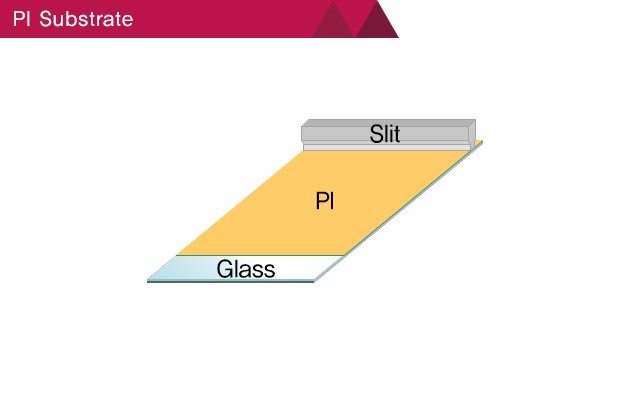
2) LTPS(Low Temperature Poly Silicon) TFT(Thin Film Transistor) technology
One of POLED’s important features is that it can have thin bezel, since the fast electron mobility technology made the integration of different parts to be possible.
3) Flexible Encapsulation Technology to protect OLED elements
With the technology to manufacture inorganic film that prevents water and organic film that prevents alien substances, plastic OLED guarantees the stability of OLED elements.
4) Elimination of Carrier Glass using laser, and adhesionof Back Plate Film
The display surface is relatively clean and neat, as it prevents foreign substance from permeating the surface, by using Laser Source Uniformity technology, alien substance/crack prevention process technology, and flat-panel Back Plate Film and Film Lamination technology.
Why Plastic OLED?
1)Compared to currently existing displays, Plastic OLED has simpler structure. As it can be seen from the diagram below, LCD is composed of many layers of boards, while OLED’s structure is very simple.
2)While glass displays are prone to breakage, Plastic OLED, which is film based, is flexible to be curved to a certain angle, and it does not break easily.
3)Compared to LCD and glass OLED displays, Plastic OLED is thinner and lighter.
The future of Plastic OLED
As Plastic OLED can be applied to curved displays that are bent to a certain curvature, it can be used in various ways, including electronic goods, such as mobile phones, monitors, and TV, as well as cars, wearable devices, and items for interior design.
Other than its design, Plastic OLED is valuable in terms of portability and durability as well. Hence, it seems that Plastic OLED will play an important role in people’s everyday lives in the future.
The Plastic OLED’s potential is very promising. LG Display is devoting its energy and resources to respond quickly to fast growing market and consumers’ needs in order to develop Plastic OLED to become the key OLED application technology in the future.
Source – LG Display Newsroom
Lenovo, impending release of Super AMOLED equipped smartphone
/0 코멘트/카테고리: /작성자: OLEDNETThe technology specialized media Gizmobic announced the impending release of Super AMOLED equipped smartphone by Lenovo.
According to the article, the price was set at 1,999 yuan (about $330) for the Lenovo Sisley S90 which resembles the look of the recently launched Apple iPhone 6. It appears quite similar to iPhone 6 from every angle except the front and back. Even it stands out as the image used for this smartphone bears the likeness to the presentation of Apple iPhone 6.
Lenovo Sisley S90 is precisely analogous to the iPhone 6 with the thickness of 6.9 mm and the weight of 129g. However, unlike the iPhone 6 equipped with 4.7-inch retina LCD display, the Sisley S90 used 5-inch Super AMOLED. So it is possible to realize the display of 100% color gamut and the contrast ratio of 30,000:1.
In addition, it is furnished with 2GHz quad-core Snapdragon 410, Adreno 306 GPU, 1GB RAM, 16GB ROM, and the battery capacity of 2,300mAh.

Source – Gizmobic
LG’s OLED TV, selected as ‘the best TV’ of the year
/0 코멘트/카테고리: 포커스온 /작성자: OLEDNETThe OLED TV of LG Electronics was named as the ‘Best TV’ of the year.
The U.S based review media ‘Reviewed.com’ selected the LG’s 55EA9800 Curved OLED TV ($9,999) as the ‘Best of year’, announcing on their website. In the TV priced under $10,000 section, it received the highest point of 10.0 and also four of assessed OLED TVs scored the highest point as well.
Compared to the Samsung’s OLED TV KN55S9C, it was unable to improve the color production but it showed the color gamut of about 20% when using the displaying content. Furthermore, it was evaluated that the motion process was enhanced slightly.
LG’s OLED TV 55EA9800 was awarded the ‘Best Television of the Year’ and the ‘Best OLED TV of the Year’, and 55EA8800 earned the ‘Best Design of the Year’ by the Reviewed.com. And as the Smart TV+web OS obtains the ‘Best Smart TV Platform of the Year’, LG prepared a platform for the OLED era in the TV industry.
<LG’s OLED TV posted on the reviewed.com website – Source: Reviewed.com>
Source – Reviewed.com
Samsung, to open market for UHD panel for mobile device
/0 코멘트/카테고리: /작성자: OLEDNETPhonearena, a dedicated website providing smartphone related information, reported that Samsung will start mass production of 5.9-inch UHD Super AMOLED above 700ppi in August next year.
The source of this news is not clear but at the last Analyst Days event, Samsung said that it is expected to produce UHD 2160×3840 AMOLED display in 2015. In addition, they also hinted the UHD display for a smartphone device through the roadmap presented at the workshop held last January using the word ‘diamond pixel’. This is closer to the PenTile method than the RGB stripe method.
They also mentioned 600ppi in the interview with LG Display in May of last year. And even added that the 700ppi panel for a smartphone device is eminent and Samsung’s effort for high picture quality is not surprising. It was reported that besides Samsung and LG, Sharp is recently working on 4K display for a mobile device which comes in as 5.5-6 inches.
It was measured that the UHD picture quality will be 746ppi for 5.9-inch panel. If it is intended for August of next year, the announcement is expected to be at IFA 2015, equipped in the Note 5.

Source – PhoneArena
eMagin, microdisplay 시장을 선도할 IHMD 개발
/0 코멘트/카테고리: /작성자: oled미국 소재의 OLED microdisplay 전문 기업 eMagin이 microdisplay의 다음 세대가 될Immersive Head Mounted Display(IHMD)을 개발했다고 자사 홈페이지를 통해 밝혔다.
이 IHMD는 상당히 크고 낮은 해상도의 cell phone display와 conventional optics보다 eMagin의 최근 2k by 2k high-resolution OLED microdisplay와 patented optics을 탑재하고 있다.
eMagin의 CEO, Andrew Sculley는 ‘우리의 IHMD는 다양한 application을 개발하여 VR HMD의 성능과 시야에 패러다임 변화를 일으킬 것이다.’라고 말했다. 또한 IHMD의 개발의 수석 부사장, Jerom Carollo는 ‘OLED microdisplay는 VR HMD counter part의 크기와 무게가 절반이 될 수 있는 근본적인 이유다.’라고 말했다.
시야는 100도 이상이고 해상도는 1 megapixel per eye(MP/eye)부터 4 MP/eye까지 가능하다. IHMD는 ‘flip-up’이라는 viewer기능과 같은 다른 VR HMD들에서는 찾을 수 없는 기능들을 가지고 있다.
eMagin은 IHMD를 런칭하기 위해 이름 공모전을 진행할 것이라고 밝혔다. 첫 번째 prototype은2014년 말에 완성될 예정이고, 해상도는 4 MP/eye가 될 것이다. eMagin은 IHMD가 게임, 의료,건축, 3D 디자인, 교육, 군사적 용도 등의 다양한 방면에서 적용되길 바라고 있고, 처음 목표는 게임 시장이라고 밝혔다.
LG ‘올레드 TV’, 3년 연속 ‘CES 혁신상’ 수상
/0 코멘트/카테고리: /작성자: oledLG전자 ‘가변형 올레드 TV’와 ‘G3’가 ‘CES 2015’ 혁신상을 수상했다.
이로써 LG ‘올레드 TV’와 ‘G시리즈’는 3년 연속으로 ‘CES 혁신상’을 수상하게 됐다. 두 제품 모두 2012년 첫 공개 후, 단 한 번도 ‘CES 혁신상’을 놓치지 않았다. ‘CES 2103’에서는 ‘평면 올레드 TV’와 ‘G’가 받았고, ‘CES 2014’에서는 ‘77형 울트라 올레드 TV’와 ‘G2’가 각각 혁신상을 수상한 바 있다.
LG전자 ‘가변형 올레드 TV’는 리모컨으로 화면곡률을 사용자가 원하는 각도로 휘어질 수 있도록 설계한 제품이다. 곡률은 평면부터 화면 크기와 시청 거리 등을 종합적으로 고려한 최대 곡률까지 조정 가능하다. 사용자가 원하는 곡률로 조작 가능하기 때문에 TV를 보는 환경과 상황에 따라 최적화된 시청 경험을 제공한다.
‘LG G3’는 최고의 기술들을 담았지만, 가장 간편하게 사용하면서 가장 뛰어난 사용자 경험을 제공하는 스마트폰에 초점을 맞춘 제품이다. 쿼드HD IPS 디스플레이가 선사하는 최고의 화질,레이저 빔을 쏘아 빠르게 초점을 잡아주는 레이저 오토 포커스 카메라, 심플하면서 고급스러운 외관 디자인, 사용자를 이해하는 진정한 스마트 UX(사용자 경험) 등 국내외 언론과 소비자의 호평을 받고 있다.
LG전자는 ‘CES 2015’에서 TV부문 4개, 모니터, 휴대폰 등 IT제품 2개, 생활가전 4개 등 총10개 부문에서 혁신상을 수상했다.
‘CES 혁신상’은 다음해 1월 미국 라스베이거스에서 열리는 세계최대 가전전시회‘CES(Consumer Electronics Show)’의 출품 제품을 대상으로 미국가전협회(CEA)와 미국산업디자인협회(IDSA)가 기술과 디자인을 평가해 선정한다.
Source – LG전자
Dell Venue 8 7000, the emergence of the OLED equipped 6mm tablet PC
/0 코멘트/카테고리: /작성자: OLEDNETThe Dell Venue 8 7000 Series is the thinnest tablet PC in the world that comes with the thickness of only 6mm. It has a display panel of 1600 x 2560, a pixel density of 359 ppi and the functions of the multi-touch and light sensor are built in this product.
The camera is 8M and 2M for the use of selfi mode with the system chip of Intel Atom and the processor of Quad core.
The OLED panel is expected to be the one that is produced by the Samsung Display as it has the same resolution with the panel employed for the tablet PC Galaxy Tab S SM-T700 that the Samsung Electronics has released.
Source: phone Arena.com
LG Electronics, to open an era of OLED TV
/0 코멘트/카테고리: /작성자: OLEDNETAs the sales of the LG Electronics 55-inch Curved OLED TV (Model: 55EC9300) exceeds over 1,000 units since it became available at the end of last September, it is leading the era of OLED TV popularization.
LG Electronics released the curved OLED TV at KRW 3.99 million which is 1/4 of the price of the product launched early last year at KRW 15 million. The sales amount has increased drastically more than 20 times as the price becomes affordable due to the improvement of panel yielding rate. According to the LG Electronics, the customers who used to hesitate to purchase the OLED TV because of the high price are coming back making increased inquiries.
And the favorable reviews from various media regarding the picture quality of the LG OLED TV are continued. The U.S. IT media Cnet said, “This product has the best picture quality ever conform to the expectations for the OLED” and touted “It is the greatest TV existing in the world that even the latest 4K LCD cannot surpass.”
The Reviewed.com also highly praised stating that “It is the product with the real infinite contrast range” and “It is the first TV offering such an excellent picture quality.”
The LG’s 55-inch Curved OLED TV realized the ultra slim thickness of 4.9mm as it does not need a backlight. Though it is a curved TV, there is little color distortion changing according to the viewing angle, providing more precise color and deeper picture quality than general LCD TV even in the various genres of viewing environments including drama, sports, movie, documentary, etc.
Huh Jae-chul, marketing director of LG Electronics, said that “The OLED TV is a completely different TV that presents realistic colors and the contrast range that no LCD TV can match” and “The increase of sales is the evidence that consumers’ experiences of the great picture quality are directly leading to the actual purchase.”
Source – LG electronics
Solution Processing OLED Era is coming
/0 코멘트/카테고리: /작성자: OLEDNETAt the International Workshop on Flexible & Printable Electronics, IWFPE held in Jeonju, Konica-Minolta and DuPont presented diverse technologies that converts the OLED production process which requires a glass substrate into the technology of using a flexible substrate and printing technology.
Konica-Minolta is under development of the OLED panel for lighting and the production of a flexible OLED panel as a printing technology of R2R method for the first time in the world is imminent. Based on the camera film production technology, Konica-Minolta has a wide range of light-emitting materials technology and also the R2R technology at the same time, getting attention as a front-runner to open a new era of flexible electronics.
DuPont is the pioneer of the solution processed OLED display business as well. Equipped with the nozzle printing method which is its own printing technology, it continued to research and develop for many years with Samsung Display. The most critical benefit of the solution OLED is that it is the only technology to manufacture a large area OLED panel over 55-inch with RGB method at a large equipment bigger than the Gen8. DuPont completed the technological development of containment creation, ink deposition, and ink drying which are the essential technologies for the production of the solution OLED panel and is accelerating the commercialization. DuPont prospects that the solution OLED panel market will be open within three years at the latest.
SolMateS, 무손상 ITO 증착 기술 개발
/0 코멘트/카테고리: 기술, 기술, 기술, 기술, 기술, 기술, 기술, 기술 /작성자: oled네덜란드의 증착 장비 전문 업체 SolMateS는 새로운 OLED 증착공정을 개발했다고 밝혔다.
SolMateS에서 이번에 개발한 증착공정은 Full transparent OLED 공정으로 SolMateS의pulsed laser deposition(PLD)를 기반으로 한 ‘soft-landing’이라는 기술로서 이미 특허도 확보하였다. SolMateS에 의하면, sputtering과 같은 기존의 증착기술은 organic layers에 손상을 줄 수 있지만, ‘soft-landing’ 방법은 균등한 공정 온도에서 진행되어 ITO thin layer를 OLED 위에 손상 없이 쌓을 수 있다고 한다.
최근 테스트 결과 80%의 투명도를 가진 OLED가 투명도가 없는 aluminum electrode의OLED와 기능상 큰 차이를 보이지 않았다고 밝혔다. 또한 sputter의 속도로 ITO가 증착되었고, 200mm의 PLD tool이 가능하다.
SolMateS의 CEO인 Arjen Janssens는 ‘PLD 기술은 투명 조명, 디스플레이, 스마트 윈도우나top emitting OLED display와 같은 multiple transparent를 이용한 OLED 어플리케이션에 사용될 수 있으며, 고효율 organic solar cells에도 큰 도움이 될 것이다.’라고 언급 했다.
SolMateS는 2006년 네덜란드에서 시작되었으며, 레이저 증착을 기반으로 한 증착장비 공급업체이다.
Source – SolMateS
[Analyst Column] Samsung Display, shooting for the future of display
/0 코멘트/카테고리: /작성자: OLEDNETThe DVCE (Display Valley Conference & Exhibition), supported by Samsung Display is held in every November in Asan, Chungcheongnam-do as one of the major events in the region which has established its position as a mecca of display industry. It is an international conference created by the active support from Samsung Display for the purpose of local development and industrial development of display business and it is the 10th year of DVCE in 2014.
In the first day of DVCE on the 11th, Hak-sun Kim, the vice president of Samsung Display gave a key note speech titled “Display Beyond Imagination”, suggesting the future directions for display through humanistic considerations.
Given that most of display related conferences or seminars are primarily of hardware or technology associated contents, this was the first occasion that the directions for the future display was proposed. Comparing the display with the history of art, Kim defined a new technology market to converge analog and digital. He mentioned the necessity to produce creative display by employing new functions in display as famous art masters have created innovative artworks by developing various techniques.
In particular, he has emphasized that it is critical to produce a human-friendly product as a human interface through fundamental understanding and reflection on the light and human eyes when developing a display. Kim proposed a vision for the future of the convergence product equipped with varied functions like lighting and eye, bio sensor, haptic sensor, etc. through the techniques employed by the artists like lighting and perspective, trompe I’oeil, texture, etc.
Kim expressed sincere regret for the decrease of display industry in Korea where new products are no longer produced, claiming the need for engineers who develop displays to converge and combine by means of humanistic consideration in order to promote display industry.
Yi Choong-hoon /Chief Analyst / UBI Research / ubiyi@ubiresearch.co.kr
[Analyst Column] 삼성디스플레이, 디스플레이 미래를 쏜다
/0 코멘트/카테고리: /작성자: OLEDNET매해 11월이면 충청남도 아산에서 삼성디스플레이가 후원하는 DVCE (Display Valley Conference & Exhibition) 2014가 개최된다. 10회를 맞이한 DVCE는 디스플레이 산업 메카로 자리잡은 충청남도의 주요 행사로서, 삼성디스플레이의 적극적인 지역 발전과 디스플레이 산업 발전을 위해 만들어진 국제 학술 행사이다.
DVCE 첫날인 11일에 삼성디스플레이 연구소장인 김학선 부사장은 “Display Beyond Imagination”이란 제목으로 키 노트 연설을 통해 디스플레이가 가야 할 미래를 인문학적 고찰을 통해 제시하였다.
대부분 디스플레이 관련 학회나 세미나에서는 하드웨어와 기술에 대한 내용이 일반적이어서 향후 디스플레이가 발전해 나가야 할 방향을 제시해 주는 예는 없었다. 김학선 부사장은 키 노트에서 미술사와 디스플레이를 비교하며 아날로그와 디지털이 융합할 수 있는 신 기술 시장을 정의하였다. 과거 유명한 미술가들이 다양한 기법을 개발하며 창의적인 작품을 창작한 것처럼 디스플레이에도 새로운 기능을 부가하여 창의적인 디스플레이가 만들어져야 함을 언급하였다.
특히 디스플레이를 개발할 때는 빛과 인간의 눈에 대한 근본적인 이해와 고찰을 통해 human interface로서 친인간적인 제품으로 거듭나야 함을 강조하였다. 김부사장은 미술가들이 작품을 만들 때 이용하는 조명과 원근법, 입체화법, 질감 등을 디스플레이에도 응용하여 조명과 눈, 바이오 센서, 햅틱 센서 등 다양한 기능을 디스플레이에 내장한 융합 제품을 미래 상품으로 비젼을 제시하였다.
김부사장은 최근 한국 디스플레이 산업이 축소되어 가며 새로운 제품이 나오지 못하는 것에 대해 매우 유감스럽게 생각하며, 디스플레이 산업을 부흥 시키기 위해서는 디스플레이를 개발하는 엔지니어들로 인문학적 고찰을 통한 융합과 조합을 시도해야 함을 피력했다.
이충훈 / 수석 애널리스트 / 유비산업리서치 / ubiyi@ubiresearch.co.kr
Asus, ZenWatch로 smart watch 시장 진입
/0 코멘트/카테고리: 세트 /작성자: oled외국 매체 Techcrunch가 Asus가 OLED를 탑재한 ZenWatch를 미국에서 현지 시간 11월 9일 기준으로 $ 199로 출시한다고 보도했다.
Asus ZenWatch는 Google Android Wear device로 지난달 28일 일본 매체에 의하면 일본에서11월 하순에 출시한다고 보도된 바 있다. 일본에서는 ZenWatch와 ZenFone5가 이번 달에 출시되며 동시 구매 시에는 5,000엔의 가격 할인이 적용된다고 한다. 하지만 ZenWatch의 가격이32,184엔으로 미국 출시 가격과 약 $ 90정도 차이가 난다.
ZenWatch는 1.63인치 320×320의 AMOLED touch display를 탑재하고 있다. 세부 스펙으로는 퀄컴 스냅드래곤 400과 1.2GHz CPU, 512MB RAM와 Bluetooth 4.0 기능, Polymer 1.4Wh의 배터리 기능을 가지고 있다.
Source – TechCrunch
[useful_banner_manager banners=5 count=1]
삼성, UHD 모바일용 패널 시장 여나
/0 코멘트/카테고리: /작성자: oled스마트폰 전문 매체 Phonearena에서 삼성이 700ppi 이상의 5.9인치 UHD Super AMOLED를 내년 8월에 양산을 시작할 것이라고 보도했다.
이 내용이 출처가 분명하진 않지만 삼성은 작년 Analyst Days 행사에서 UHD 2160×3840 AMOLED display를 2015년에 생산을 할 것이라고 말한 적이 있다. 게다가 지난 1월에 열린 워크숍에서도 로드맵을 통해 UHD 스마트폰용 display에 힌트를 준 부분도 있었다. 이와 함께 다이아몬드 픽셀이라는 단어도 사용했다. 이는 일반적인 RGB stripe 방식보다 PenTile방식에 가깝다.
지난 5월 LG Display와의 인터뷰에서도 600ppi에 대해 언급했었다. 심지어 700ppi 스마트폰용 패널의 출현은 얼마 남지 않았고, 삼성의 고화질을 위한 노력은 놀랄 일이 아니라고 말했다. 삼성, LG 외에 Sharp는 최근에 4K 모바일용 display를 위해 작업 중이라는 소식도 있었고, 5.5-6인치가 될 것이라고 밝혔다.
계산한 바에 의하면 5.9인치 패널 기준으로 UHD 화질은 746ppi가 될 것이다. 내년 8월이라면 시기상 IFA 2015에서 공개할 것이며, 노트5에 탑재될 것으로 보고 있다.
Source – PhoneArena
LG의 OLED TV, 올해 ‘최고의 TV’ 선정
/0 코멘트/카테고리: /작성자: oledLG전자의 OLED TV가 올해 ‘최고의 TV’로 선정되었다.
미국 소재의 리뷰 전문 매체인 ‘리뷰드닷컴’은 LG전자의 55EA9800 Curved OLED TV($9,999)를 ‘Best of year’로 선정하여 홈페이지에 게시하였다. 올해의 TV 제품 중 $10,000 미만 TV부문에서 총점 10.0으로 가장 높은 점수를 받았다고 밝혔다. 평가를 실시한 4개의 OLED TV에서도 최고점을 획득하였다.
특히 삼성의 OLED TV인 KN55S9C와 비교하여 color production을 향상시키진 못했지만displaying content를 사용할 때 약 20%의 color gamut을 나타낸다고 말했다. 또한 motion처리에도 소폭 향상된 것으로 평가하였다.
리뷰드닷컴에서 LG의 OLED TV 55EA9800은 ‘Best Television of the Year’, ‘Best OLED TV of the Year’를 받았고, 55EA8800은 ‘Best Design of the Year’를 받았다. 또한 Smart TV+webOS는 ‘Best Smart TV Platform of the Year’를 받아 LG는 TV부문에서 OLED시대의 발판을 마련했다.
<리뷰드닷컴 홈페이지에 게재된 LG전자의 OLED TV ? Source : 리뷰드닷컴>
Source ? 리뷰드닷컴
Lenovo, Super AMOLED 탑재 스마트폰 출시 임박
/0 코멘트/카테고리: /작성자: oled기술 전문 매체인 Gizmobic는 Lenovo에서 Super AMOLED를 탑재한 스마트폰을 출시한다고 보도했다.
기사에 따르면, 최근 애플에서 출시한 iPhone 6와 외관이 비슷한 Lenovo Sisley S90을 중국에서 공식가 1,999위안(약 $330)에 책정되었다. 전면과 후면을 제외한 모든 각도에서 iPhone 6의 모습과 비슷하다. 또한 이 스마트폰의 이미지를 애플 iPhone 6의 presentation과 흡사한 이미지를 사용한 점도 눈에 띤다.
Lenovo Sisley S90은 6.9mm의 두께와 129g의 무게로 정확하게 iPhone 6와 일치한다. 하지만4.7inch Retina LCD display를 탑재한 iPhone 6와는 달리 Sisley S90은 5inch Super AMOLED를 사용하였다. 때문에 색재현율 100%와 명암비 30,000:1의 display를 구현할 수 있다.
그 외에 1.2GHz 쿼드코어 Snapdragon 410, Adreno 306 GPU, 1GB RAM과 16GB ROM, 2,300mAh의 배터리 용량을 가지고 있다.
Source – Gizmobic
유비산업리서치, ‘OLED 핵심 기술 세미나’ 개최
/0 코멘트/카테고리: 기타 /작성자: oled유비산업리서치(www.ubiresearch.co.kr, 대표 이충훈)는 오는 19일 SETEC 컨벤션홀에서‘OLED 핵심 기술 세미나’를 개최한다고 밝혔다.
이번 세미나는 OLED 산업에 이슈 되고 있는 기술인 flexible OLED와 encapsulation(봉지기술), TFT, solution process 공정에 대한 주제로 OLED 산업에서 관심도가 높고 주목할 만한 기술의 현황과 전망에 대해 집중 소개한다.
Flexible AMOLED 패널은 2013년 한국에서 세계최초 양산이 시작되고 뒤이어 올해에는flexible AMOLED를 적용한 Galaxy Gear S, LG G Watch R과 같은 smart watch와 Galaxy Edge등 smart phone이 출시되면서 flexible AMOLED 산업에 대한 관심이 높아지고 있다. ‘OLED 핵심 기술 세미나’에서는 고려대학교 홍문표 교수가 ‘Flexible AMOLED 기술의 오늘과 내일’이라는 주제로 Varnished IP Film 기반의 AMOLED panel 양산을 위한 기술 확보 현황과 한계, 이를 극복하기 위한 새로운 기술들에 대한 조망을 제시할 예정이다. 또한 ‘flexible OLED에 적용되고 있는 touch 기술 동향과 제조 공정’을 KETI 곽민기 센터장이 발표할 예정이다.
OLED TV가 출시되고 대면적 AMOLED 패널이 LCD에 가격경쟁력을 갖추기 위해 제시된 기술은 바로 solution process(용액공정)이다. 부산대학교 진성호 교수는 진공증착용과 용액공정용OLED 재료의 현황과 전망이라는 주제를 통해서 진공증착용 OLED 재료 대비하여 solution process의 재료가 현재 어느 수준으로 개발되어 있는지를 발표할 예정이다.
이번 세미나에서 OLED 산업 관계자가 주목할 만한 또 다른 프로그램으로는 대면적 AMOLED양산을 위해 적합한 ‘AMOLED TV용 Oxide TFT의 기술적 이슈와 전망’과 주요 AMOLED panel업체들의 기술동향을 다룬 ‘AMOLED 기술동향 분석’, 대면적과 flexible 디스플레이를 위한encapsulation 기술의 내용이 포함된 ‘OLED encapsulation 기술 동향’ 등이 준비되어 있다.
유비산업리서치 이충훈 대표는 “현재 한국 디스플레이 산업에서 OLED는 선택이 아니라 필수이다. OLED 산업을 계속적으로 주도하기 위해서는 현재 문제점을 파악하고 빠르게 해결하는 것이 중요하다.”며 “이번 세미나를 통해 OLED 관련 업체와 연구소, 학계 종사자들이 OLED 산업이 보다 성장하기 위해 현재 OLED 산업의 기술적 트렌드와 이슈, 발전 방향을 나눌 수 있는 교류의 장이 되길 바란다.”고 말했다.
세미나 참가신청은 유비산업리서치 홈페이지에 개설된 2014년 OLED 핵심 기술 세미나 안내를 통해 가능하다.
LGD, Plastic OLED 기술 공개
/0 코멘트/카테고리: 기술 /작성자: oledLG Display(이하 LGD)가 자사의 G Watch R에 적용된 plastic OLED기술을 공개하며 적극적인 홍보에 나서고 있다.
LGD의 미국 뉴스룸(http://lgdnewsroom.com/)에 ‘The New Advancement in Display technology: LG Display’s Plastic OLED’이라는 이름으로 게재되어 있으며 그에 대한 내용은 아래와 같다.
The New Advancement in Display technology: LG Display’s Plastic OLED
What is Plastic OLED?
Plastic OLED is an OLED that is made out of plastic substrate. There are 4 very special key technologies applied to this OLED.
1) Plastic, not glass
LG Display has shattered the common belief that plastic cannot stand high temperatures, and developed plastic substrate (PI or polyimide) that remains stable under high temperatures and has chemical stability. Moreover, due to the development of the coating process of large format PI, it has become possible to manufacture PI film, which has enabled the plastic curving technology and the technology to eliminate unnecessary bubbles and foreign substances.
2) LTPS(Low Temperature Poly Silicon) TFT(Thin Film Transistor) technology
One of POLED’s important features is that it can have thin bezel, since the fast electron mobility technology made the integration of different parts to be possible.
3) Flexible Encapsulation Technology to protect OLED elements
With the technology to manufacture inorganic film that prevents water and organic film that prevents alien substances, plastic OLED guarantees the stability of OLED elements.
4) Elimination of Carrier Glass using laser, and adhesion of Back Plate Film
The display surface is relatively clean and neat, as it prevents foreign substance from permeating the surface, by using Laser Source Uniformity technology, alien substance/crack prevention process technology, and flat-panel Back Plate Film and Film Lamination technology.
Why Plastic OLED?
1) Compared to currently existing displays, Plastic OLED has simpler structure. As it can be seen from the diagram below, LCD is composed of many layers of boards, while OLED’s structure is very simple.
2)While glass displays are prone to breakage, Plastic OLED, which is film based, is flexible to be curved to a certain angle, and it does not break easily.
3)Compared to LCD and glass OLED displays, Plastic OLED is thinner and lighter.
The future of Plastic OLED
As Plastic OLED can be applied to curved displays that are bent to a certain curvature, it can be used in various ways, including electronic goods, such as mobile phones, monitors, and TV, as well as cars, wearable devices, and items for interior design.
Other than its design, Plastic OLED is valuable in terms of portability and durability as well. Hence, it seems that Plastic OLED will play an important role in people’s everyday lives in the future.
The Plastic OLED’s potential is very promising. LG Display is devoting its energy and resources to respond quickly to fast growing market and consumers’ needs in order to develop Plastic OLED to become the key OLED application technology in the future.
Source ? LG Display Newsroom
UDC, OLED 시장 개화 기다린다
/0 코멘트/카테고리: 시장, 시장 /작성자: oled지난 6일, 미국의 패널 업체 Universal Display Corporation(이하 UDC)가 2014년 3사분기 실적발표를 10워 30일에 했다고 홈페이지를 통해 밝혔다.
올해 3분기 매출은 $32.9 million으로 작년 $32.8 million의 3분기 매출과 비슷하다. 로열티와license fees가 작년 3분기 $1.5 million에서 $5.4 million으로 오르면서 소폭 상승한 것으로 분석된다. 또한 재료 영업이 $30.3 million에서 $27.5 million의 9% 감소한 부분도 포함한 실적이다. 특히 host 재료의 매출이 좋지 않아 하락한 것으로 분석되었다. 영업이익은 $6.1 million으로 작년 동기 대비 $1.9 million 오른 것으로 보고되었다.
2014년 3사분기까지 매출은 $134.9 million으로 2013년 동기 대비 39%나 올랐다. 아직 OLED산업이 초기 단계에 있어 재료에 대한 수요가 많지 않았지만 UDC는 보고서를 통해 변수는 아직 남아있다고 밝혔다. 때문에 올해 매출은 $183 million에서 $185 million이 될 것으로 기대하고 있다.
용액공정 기반 고효율 형광 유기발광 소자 개발
/0 코멘트/카테고리: /작성자: OLEDNET국내 연구진이 차세대 디스플레이로 주목받는 유기발광소자의 효율을 3배 이상 향상시킬 수 있는 고효율 형광 유기발광소자를 개발했다.
단국대 고분자공학과 이준엽 교수, 조용주 박사과정 연구원(제1 저자) 및 육경수 교수가 공동으로 참여한 이번 연구는 미래창조과학부와 한국연구재단이 지원하는 중견연구자지원사업 및 교육부와 한국연구재단이 지원하는 일반연구자지원사업의 지원을 받았고 연구결과는 재료 분야 국제학술지 어드밴스드 머티리얼스(Advanced Materials)지 10월 15일자에 게재되었다.(논문제목 : High Efficiency in a Solution-Processed Thermally Activated Delayed-Fluorescence Device Using a Delayed-Fluorescence Emitting Material with Improved Solubility)
용액공정을 이용하면 기존 진공증착 공정에 비해 유기발광소자를 대면적으로 만들기 쉽고 공정이 비교적 단순해질 것으로 기대를 모으고 있다.
하지만 기존 형광 발광물질을 이용, 용액공정에서 소자를 제조할 경우 효율(외부양자효율)이5%에 불과한 수준으로 진공증착 공정으로 제조할 경우 효율 20%에 미치지 못하는 것이 문제였다.
연구팀은 기존 용액공정용 형광소자보다 3배 이상 개선된 고효율(외부 양자효율 18.3%)의 형광 유기발광소자를 개발하였다. 기존 구조에 비해 알킬기를 치환기로 도입하여 용해도를 개선하였다. 또한 지연 형광 현상을 유도해 고효율을 구현하기 위하여 도너–억셉터 구조로 구성되는 분자 구조를 도입하였다.
향후 디스플레이의 대형화를 위한 대형 유기발광소자의 실용화를 앞당기는 데 기여할 것으로 기대된다.
유기용매에 잘 녹는 새로운 형광 발광물질을 개발하여 소자의 필름표면 코팅이 매끄럽게 이뤄지도록 해 효율저하를 극복했다.
또한 강한 전자 주게–전자 받게 구조를 도입, 지연형광현상을 유도함으로써 효율을 개선할 수 있었다. 전자 주게–전자 받게 구조는 단위체를 말하며, 전자를 다른 단위체에 주는 성질을 가진 단위체와 잘 받는 성질을 갖는 단위체를 뜻한다.
이 교수는 “향후 소자의 효율뿐 아니라 소자의 수명도 개선하기 위한 신규 물질 개발과 용액공정에 적합한 소자 구조 개발로 용액공정용 고효율 형광 유기발광소자를 상용화하기 위한 후속연구를 지속할 계획”이라고 밝혔다.
용액 공정 OLED 시대 다가온다
/0 코멘트/카테고리: /작성자: oled전주에서 개최되고 있는 인쇄전자 학술대회 IWFPE에서 Konica-Minolta와 DuPont은 유리 기판을 사용하는 OLED 제조 공정이 flexible 기판과 프린팅 기술을 사용하는 기술로 전환 될 수 있는 다양한 기술을 소개했다.
Konica-Minolta는 조명용 OLED 패널을 개발 중에 있으며 세계 최초로 R2R 방식의 프린팅 기술로서 flexible OLED 패널 생산을 목전에 두고 있다. Konica-Minolta는 카메라용 필름 제조 기술을 바탕으로 다양한 발광재료 기술을 보유하고 있으며, 동시에 R2R 기술을 확보하고 있어 유연전자 시대를 열수 있는 선구자로 주목 받고 있다.
DuPont 역시 용액 공정 OLED 디스플레이 분야에서 선구자이다. 독자적인 프린팅 기술인 노즐 프린팅 방식의 장비와 재료를 바탕으로 삼성 디스플레이와 수년간 연구 개발을 지속해왔다. Solution OLED의 가장 큰 장점은 Gen8 이상의 큰 장비에서 RGB 방식으로 55인치 이상의 대면적 OLED 패널을 생산 할 수 있는 유일한 기술이기 때문이다. DuPont은 solution OLED 패널을 제조하기 위해 필수적인 기술 요소들인 containment creation 기술과 ink deposition, ink drying기술 개발을 완료하고 상용화에 박차를 가하고 있다. DuPont에서는 solution OLED 패널 시장은 늦어도 3년 후부터 열릴 것으로 기대하고 있다.
Declining Japan’s Display Industry
/0 코멘트/카테고리: /작성자: OLEDNETThe downtrend of Japanese display industry became obvious once again at the Display Innovation. Originally titled as the FPD International, the Display innovation 2014 was renewed with a different name to evoke a fresh wind in the display industry of Japan, only to find that it had failed to draw attention from the interested parties of the FPD industry.
At the FPD International 2013 held last year, about 200 FPD related companies participated whereas only 80 companies exhibited at the Display Innovation of this year, and the scale of the conference was also reduced drastically as implementing the event not in the existing convention center but in a section of the exhibition hall.
It was evident that the Japanese display industry is in the downturn as only Japan Display was joined as a panel company exclusive of the major Japanese panel makers like Sony, Sharp, Toshiba, Panasonic, etc.
However, it presented that the Japanese Display Industry is still alive as Japan Display reveals flexible AMOLED and technical skills to improve response rate of the LCD and color reproduction and real black, etc. of the LCD. And SEL shows AMOLED related new technologies.
< View of SEL and Japan Display Booth at Display Innovation >
Samsung, to actively respond to the low and middle priced smartphone market
/0 코멘트/카테고리: 포커스온, 포커스온, 포커스온, 포커스온, 포커스온, 포커스온, 포커스온, 포커스온, 포커스온, 포커스온, 포커스온, 포커스온, 포커스온, 포커스온, 포커스온, 포커스온, 포커스온, 포커스온, 포커스온, 포커스온, 포커스온, 포커스온, 포커스온, 포커스온, 포커스온, 포커스온, 포커스온, 포커스온, 포커스온 /작성자: OLEDNETSamsung Electronics announced the performance presentation for 3Q held on the 30th of October. IM (mobile) division recorded KRW 24.580 trillion, a quarter-on-quarter decrease of 14% and the business profit was KRW 1.75 trillion, a quarter-on-quarter decrease of 60%.
The 3Q business profits of IM showed the largest drop compared to the previous quarter since 2012, and it was the first time falling under KRW 2 trillion. It is due to fierce growth of Chinese electronic companies and a month delayed announcement of Galaxy Note 4 than the previous model, having little influence on the performance of 3Q.
Robert Yi, chief of the firm’s investor relations team said, “We failed to quickly respond to the market flow of smartphones which is changing its focus towards price competition.” In view of that, Kim Hyun-joon, a senior executive at its mobile division, said “We will increase the profitability as actively response to the low and middle priced market” and the competitiveness will be reinforced as differentiating display and materials, and improving camera, AP system, etc.

Samsung Electronics unveiled the Galaxy A series targeting the low and middle priced market, on the 31st, only a day after unveiling the strategy regarding the low and middle priced market. With full metal body design, ‘Galaxy A5’ and ‘Galaxy A3’ are the slimmest Galaxy smartphones to the thickness of 6.7mm and 6.9mm respectively. Furthermore, Galaxy A5 and A3 is equipped with the 5-inch and 4.5-inch correspondingly, and front camera of diverse selfie functions and the very first five million pixels, targeting young consumers who are the most frequent selfie mode users. The price range is expected to be about 400 – 500 million won, and it will begin to release in November at the selected countries including China.
There is much attention towards whether Samsung Electronics will bring about good results with the full metal bodied Galaxy A series at the heart of China’s enormous price competitiveness.
LG전자, OLED TV 대중화 시대 연다
/0 코멘트/카테고리: /작성자: oledLG전자 55형 곡면 올레드 TV(모델명: 55EC9300)가 지난 9월 말 출시 이후 한 달 만에 판매량 1,000대를 넘어서며 올레드 TV 대중화 시대를 이끌고 있다.
LG전자는 지난 9월 말 곡면 올레드 TV를 판매가 399만원에 출시했다. 지난 해 초 1,500만원에 출시한 제품과 비교하면 가격은 1/4 수준에 불과하다. 패널 수율 향상 등으로 가격이 현실화 되며 판매량은 20배 이상 급증했다. LG전자에 따르면 그간 올레드 TV를 구매하고 싶어도 상대적으로 높은 가격 때문에 망설였던 소비자들의 구매 문의도 증가하고 있다고 한다.
이와 더불어 LG 올레드 TV의 화질에 대한 매체들의 호평도 이어지고 있다.
美 IT 매체 씨넷(Cnet)은 “이 제품은 현존 최고의 화질로 올레드에 대한 기대에 부응한다”며,“최신 4K LCD와 비교해봐도 LCD가 절대 넘어설 수 없는 현존하는 최고의 TV다”라고 극찬했다.
리뷰드닷컴(Reviewed.com)도 “진정한 무한 명암비를 가진 제품”이라며, “이렇게나 뛰어난 화질의 TV는 처음이다”고 호평했다.
LG 55형 곡면 올레드 TV는 백라이트가 필요 없어 4.9mm의 초슬림 두께를 구현했다. 곡면TV임에도 시야각에 따른 색상의 변화가 거의 없다. 드라마, 스포츠, 영화, 다큐멘터리 등 다양한 장르의 방송시청 환경에서도 일반 LCD TV보다 더욱 정확한 색상과 깊이감 있는 화질을 제공한다.
LG전자 한국HE마케팅담당 허재철 상무는 “올레드 TV는 LCD TV로는 따라올 수 없는 사실적인 색상과 명암비를 보여주는 차원이 다른 TV다”며 “판매량 증가는 올레드의 뛰어난 화질에 대한 소비자 경험이 실구매로 이어지고 있는 것”이라고 말했다.
Source – LG전자
Dell Venue 8 7000, OLED 탑재 6mm tablet PC 등장
/0 코멘트/카테고리: /작성자: oledDel Venue 8의 7000 시리즈는 세상에서 가장 얇은 tablet PC로서 두께는 6mm에 불과하다. 이 제품은 1600 x 2560 해상도 359ppi OLED 패널을 탑재하였다. Multi-touch와 light sensor기능이 내장되어 있다.
카메라는 8M와 selfi용 2M이며, 시스템칩은 Intel Atom, 프로세스는 Quad core이다.
OLED 패널은 삼성전자가 출시한 tablet PC 갤럭시 탭S SM-T700에 탑재된 것과 동일한 해상도를 가지고 있어 삼성디스플레이에서 생산하는 패널로 예상된다.
Source: phone Arena.com
Flexible AMOLED의 위력
/0 코멘트/카테고리: Uncategorized /작성자: oledFlexible AMOLED가 왜 필요한가에 대해서는 많은 사람들이 의문을 가지고 있다. 이유는 flexible AMOLED는 휘어져야 한다 또는 말릴 수 있어야 한다고 생각하기 때문이며 이러한 용도의 제품이 필요한지에 대해서는 아직 모르고 있기 때문이다. 이것은 오래 전부터 flexible display를 개발하던 기업들이 꿈의 디스플레이로서 소개한 concept이기 때문이다.
Flexible display에 대해 가장 큰 오해는 말수 있는 display이다. 분명히 말하자면 현재의 기술로서는 말면 안 된다. 이유는 set가 이러한 디스플레이를 아직 수용할 수 없다. 디스플레이를 말게 되면 set는 기본적으로 원통형이 필요하다. 이 경우에는 set를 구성하고 있는 각종 부품이 모두 원통의 case에 들어가야 하기 때문에 구동 시에 발생하는 열을 방출할 수 없다. 또한 현재의 battery 기술로서는 소형의 원통에서 장시간 디스플레이와 각종 전기전자 부품을 구동할 수 있는 성능을 가진 제품이 개발되어 있지 않으며, 향후로도 막대한 시간이 걸릴 수 밖에 없다.
휘어질 수 있는 디스플레이는 현재의 기술로서도 가능하다. 또한 접을 수 있는 디스플레이도 가능하다. 이 경우에set는 현재와 마찬가지의 평편한 구조를 그대로 채택할 수 있기 때문이다. Flexible AMOLED의 가장 큰 이점은 깨어지지 않는 특징과 얇기 때문에 set의 design을 자유롭게 할 수 있는 점이다. 특히 현재의 mobile AMOLED에서 가장 큰 취약점은 frit glass를 사용하고 있어 외부 충격에 쉽게 파손 될 수 있다. BLU를 사용하는 TFT-LCD 보다도 자체 두께는 얇지만 보강 구조 때문에 두께를 줄이는 데는 한계가 있다. 그러나 flexible AMOLED는 필름으로 구성되어 있어 외부 충격에는 매우 강할 수 밖에 없다. 따라서 display의 크기가 클수록 flexible AMOLED의 가치는 더욱 커지게 된다.
Frit glass를 사용하는 mobile AMOLED 제조 한계는 약 7인치로 알려져 있다. 10인치 이상의 tablet PC용에는 사용할 수 없다는 것이 정설이다. 현재 mobile 기기는 smart phone에서 phablet로 이미 옮겨지고 있으며, 향후 거대 시장은tablet PC 시장이 될 것임은 자명하다. 이러한 시장에서 성공할 수 있는 또 하나의 AMOLED는 깨어지지 않는 flexible AMOLED이다. Flexible AMOLED가 tablet PC에 사용되면 초박형의 가벼운 tablet PC를 만들 수 있어, 소비자가 사용시 떨어뜨려도 깨어지지 않기 때문에 TFT-LCD를 사용하는 제품에 비하면 내구성이 월등히 높아질 수 있는 핵심 부품이 될 수 있다. 또한 매우 얇기 때문에 set를 design하는 메이커로서는 form factor를 자유롭게 design할 수 있어 grip감이 우수한 제품을 만들 수 있다. TFT-LCD와 대등한 두께로 가져 갈 시에는 고용량의 battery를 사용할 수 있어 사용 편이성이 매우 높아진다.
따라서 flexible AMOLED는 향후 tablet PC 시장을 지배할 수 있는 핵심 display가 될 수 있기 때문에 mobile display로서는 최고로 중요한 시장을 형성할 수 있는 cash cow로 성장할 수 있다.
삼성, 스마트폰 중저가 시장 적극 대응
/0 코멘트/카테고리: /작성자: oled삼성전자가 지난 10월 30일 3사분기 실적발표를 했다. IM(모바일)사업부는 전분기 대비 14%감소한 24조 5,800억원을 기록하였으며, 영업이익은 1조 7,500억원으로 전분기 대비 60% 하락했다.
3분기 IM 영업이익은 2012년 이후로 전분기 대비 가장 높은 하락폭을 보였으며, 또한 2조 이하의 수치는 처음 나타내었다. 이는 중국 전자업체들의 무서운 성장과 갤럭시 노트4의 전모델 대비 1개월 늦은 출시로 인해 3분기 실적에 영향을 거의 미치지 못한 이유로 판단된다.
이명진 삼성전자 전무는 “가격경쟁 중심으로 변화하고 있는 스마트폰의 시장흐름을 삼성전자가 신속히 대응하지 못한 측면이 있었다.”고 전했다. 이에 따라 김현준 삼성전자 전무는 “중저가 시장에 적극 대응해 수익성을 높이겠다”며, 디스플레이와 소재 차별화, 카메라, AP시스템 개선 등으로 경쟁력을 강화할 것이라고 말했다.
중저가 시장에 대한 전략을 공개한 1일 뒤인 31일 삼성전자는 중저가 시장을 공략하는 갤럭시 A시리즈가 공개하였다. ‘갤럭시 A5’와 ‘갤럭시 A3’는 각각 6.7mm, 6.9mm 두께로 갤럭시 스마트폰 중 가장 얇고, 풀 메탈 바디 디자인을 적용하였다. 또한 갤럭시 A5는 5인치, A3는 4.5인치 AMOLED를 탑재하였으며, 다양한 셀피 특화 기능과 최초로 500만 화소의 전면카메라를 탑재해 셀카(selfie)촬영을 많이 하는 젊은 소비자 층을 공략하였다. 가격대는 40만원~50만원선이 될 것으로 예상되며, 출시는 11월부터 중국을 포함한 일부 국가에 출시될 예정이다.
메탈을 두른 얇은 갤럭시 A시리즈로 삼성전자가 중국의 엄청난 가격경쟁력에서 좋은 성과를 이뤄낼 수 있을지 앞으로 관심이 주목되는 바이다.
시들어가는 일본의 Display 산업
/0 코멘트/카테고리: /작성자: oled일본 display 산업의 하향세가 이번 Display Innovation 2014에서 다시 한번 극명하게 드러났다. Display innovation 2014는 기존의 FPD International로서 일본 display 산업에 새로운 바람을 일으키고자 새로운 이름으로 renewal하였으나 FPD 산업 종사자들의 관심을 끌지 못한 것으로 나타났다.
지난해 개최된 FPD International 2013에서는 약 200개의 FPD 관련 업체가 참가하였으나 올해 Display Innovation에서는 약 80개 업체만이 전시하였으며 conference도 기존의 컨벤션 센터가 아닌 전시장 일부 공간을 활용하여 진행하는 등 규모가 대폭 축소되었다.
참가 panel업체는 Japan Display만 있었으며 Sony와 Sharp, Toshiba, Panasonic등의 주요 일본 panel maker들이 불참하며 일본 display산업의 하향세를 직관적으로 볼 수 있었다.
그나마 Japan Display가 flexible AMOLED, LCD의 응답속도, 색 재현력, real black등을 개선하는 기술력을 공개하였으며, SEL이 AMOLED관련 신기술들을 선 보여 일본 디스플레이 산업이 아직은 살아 있음을 보여주었다.
<Display Innovation의 SEL과 Japan Display의 부스 전경>
Japan Display, to aim to mass produce flexible and glass AMOLED for mobile device
/0 코멘트/카테고리: /작성자: OLEDNETAt the Display Innovation 2014 (FPD International) held in Yokohama, Japan from October 29 2014, Japan Display (JDI) unveiled the flexible AMOLED panel for the first time.
The flexible AMOLED panel which was presented this time employed WRGB method with PI substrate, and it is 5.2inch (FHD, 423PPI) TFE (thin film encapsulation) applied panel with the thickness of 0.05mm.
It is a new AMOLED panel released after a year and a half since the glass type 5.2-inch FHD AMOLED panel was made public on March 2013, and it demonstrates JDI’s will of business on the AMOLED panel for mobile device.
Company official from JDI OLED R&D group said, the precise time cannot be provided but they are preparing for the mass production of AMOLED panel for mobile device and the product targets are set for both flexible and glass types.
JDI is developing AMOLED panel for mobile devices at the Gen6 LTPS line of Ishikawa.
< 5.2- inch flexible AMOLED panel presented by Japan Display>
SEL, ceaseless efforts to develop AMOLED
/0 코멘트/카테고리: /작성자: OLEDNETHaving the limelight as unveiling the foldable AMOLED panel and 8K AMOLED panel for the first time at SID 2014, SEL’s technology innovation continued at this Display Innovation 2014.
The 5.9 inch foldable AMOLED display got bigger by the 8.7-inch this time, exhibited together with various products including the 27inch multi-OLED display, 2.8-inch super high resolution AMOLED panel of 1058ppi, 13.3-inch 8k(661ppi) AMOLED panel, and 3.4-inch panel for the smart watch.
Especially the 8.7 inch foldable AMOLED display drew much attention as employing the touch sensor and the 27-inch multi-OLED display which was produced by combining four of 13.5-inch AMOLED panels applying the transparent bezel technique, suggesting the probability to be the new alternative for the large area AMOLED as it is possible to produce larger than 27-inch size.
In addition, the AMOLED panel for the smart watch attracted attention as using the self-developed bendable battery.
<Transparent bezel of 3.5-inch AMOLED and 27-inch multi-OLED display combining those>
EverDisplay, to become the first Chinese company to mass produce AMOLED
/0 코멘트/카테고리: /작성자: OLEDNETEverDisplay (EDO) began the pilot production of 5.6 inch FHD AMOLED panel in October. The FHD AMOLED (1920 x 1080) panel that EverDisplay began to trial produce is a model for the 4G flagship phone using LTPS TFT with the resolution of 394ppi. The thickness and weight is 0.66mm and 12.9g respectively.
Already in the second quarter of 2014, EverDisplay was seeking customers as they succeeded in producing the 5 inch, 5.5 inch, and 6 inch HD panels. At the conference held at Shenzhen in September, they announced the success of producing the 5.6 inch FHD AMOLED panel for the first time and unveiled the panel at the same time. In addition, the 5.6 inch and 1.63 inch AMOLED panels for the wearable device were presented simultaneously.
The 1.63 inch AMOLED panel is 31.28mm x 34.78mm with the resolution of 320 x 320, 277ppi. The feature of the AMOLED panel for the wearable device that the EverDisplay revealed is that it has the same size and resolution with the Galaxy Gear 2 released by Samsung Electronics early in 2014.
EverDisplay aims to succeed in mass-producing the HD AMOLED panel in the fourth quarter of 2014 and the FHD AMOLED panel in February of 2015. If EverDisplay starts to mass produce in the fourth quarter of 2014, they will be the first Chinese Display company to implement the business. And this first step of the Chinese company is not insignificant in the OLED industry which is led primarily by the Korean companies.
Established in Shanghai on October 2012, EverDisplay focuses on the production of small and medium sized AMOLED and it holds 4.5G LTPS TFT line at present.
[VIDEO] SEL의 8.7inch tri-foldable AMOLED panel with touch sensor, Display Innovation 2014
/0 코멘트/카테고리: /작성자: oled
SEL, 끊임 없는 AMOLED 기술 증진
/0 코멘트/카테고리: /작성자: oled지난 SID 2014에서 최초로 foldable AMOLED panel과 8K AMOLED panel을 공개함으로써 큰 이슈를 불러 모았던 SEL의 기술 혁신이 이번 Display innovation 2014에서도 계속 됐다.
지난번 5.9인치였던 foldable AMOLED display는 8.7인치로 size가 커진 panel로서 공개하였으며, 27인치의 multi-OLED display, 2.8인치, 1058ppi의 초고해상도 AMOLED panel, 13.3인치 8K(661ppi) AMOLED panel, 3.4인치 smart watch용 display등 다양한 제품을 전시하였다.
특히 8.7인치 foldable AMOLED display에는 touch sensor를 탑재하여 큰 관심을 끌었으며, 27인치 multi-OLED display는 13.5인치 AMOLED panel에 투명 bezel 기술을 적용하여 4장을 결합한 것으로서, 27인치 이상의 더 큰 대면적으로도 제작 가능하다고 밝혀 대면적 AMOLED의 새로운 대안이 될 수 있음을 시사했다.
또한 smart watch용 AMOLED panel에는 자체 개발한 bendable battery를 적용하여 큰 관심을 끌었다.
<13.5inch AMOLED의 투명 bezel과 이를 결합한 27inch multi-OLED display>
Japan Display, 양산 목표는 mobile용 flexible과 glass AMOLED
/0 코멘트/카테고리: /작성자: oled2014년 10월 29일부터 일본 요코하마에서 개최된 Display Innovation 2014(FPD International)에서 Japan Display(JDI)가 처음으로 flexible AMOLED panel을 공개했다.
이번에 공개된 flexible AMOLED panel은 PI 기판에 WRGB 방식을 적용하였으며, TFE(thin film encapsulation)을 적용한 panel로서 5.2inch(FHD, 423PPI), 두께는 0.05mm이다.
JDI가 공개한 이번 flexible AMOLED panel은 2013년 3월 공개한 glass type 5.2inch FHD AMOLED panel이후 1년 반 만에 공개된 새로운 AMOLED panel 로서 JDI에서 mobile 용AMOLED panel 사업의지를 가지고 있음을 알 수 있었다.
JDI의 OLED R&D group 관계자는 정확한 시기는 말할 수 없지만 mobile 용 AMOLED panel양산을 위해 준비 중에 있으며, 제품 타겟은 flexible과 glass type 둘 다 계획 중이다 라고 밝혔다.
JDI는 현재 Ishikawa의 Gen6 LTPS 라인에서 mobile용 AMOLED 양산을 목표로 개발 중에 있다.
<Japan Display에서 공개한 5.2inch flexible AMOLED panel>
EverDisplay, 중국 첫 AMOLED 양산 업체에 더 가까워져
/0 코멘트/카테고리: /작성자: oledEverDisplay(EDO)가 5.6인치 FHD AMOLED 패널을 10월 파일럿 생산에 들어갔다. EverDisplay가 파일럿 생산에 들어간 FHD AMOLED(1920 x 1080) 패널은 4G flagship phone을 위한 모델로서 LTPS TFT를 사용하였으며, 해상도는 394ppi이다. 두께와 무게는 각각0.66mm, 12.9g이다.
EverDisplay는 2014년 2사분기에 5인치와 5.5인치, 6인치 HD 패널 생산을 성공하여 고객사를 찾고 있는 중이었다. 9월 Shenzhen에서 개최한 컨퍼런스를 통해 처음으로 5.6인치 FHD AMOLED 패널 생산을 성공하였음을 밝히는 동시에 패널을 공개하였다. 또한 5.6인치와 함께1.63인치 wearable device용 AMOLED 패널을 동시에 공개하였다.
1.63인치 AMOLED 패널은 320 x 320, 277ppi 해상도이며, 31.28mm x 34.78mm의 크기이다. EverDisplay가 공개한 wearable device용 AMOLED panel은 2014년 초에 삼성전자에서 출시한 갤럭시 기어2와 동일한 사이즈와 해상도를 가진다는 점이 특징이다.
EverDisplay는 HD AMOLED 패널 양산은 2014년 4사분기에 성공하여 FHD AMOLED 패널은2015년 2월에 양산시작을 목표로 하고 있다. EverDisplay가 2014년 4사분기에 양산을 시작할 경우 중국 디스플레이 업체 중 최초 양산 시작이 되는 것이다. 현재까지 한국이 주도하고 있는OLED 산업에서 중국업체가 첫 발을 내딛는 다는 것은 작은 의미는 아닐 것이다.
EverDisplay는 상하이에 2012년 10월에 설립되었으며, 중소형 AMOLED 생산에 집중하고 있다. 현재는 4.5G LTPS TFT 라인을 보유하고 있다.
LG Display, OLED will continue next year
/0 코멘트/카테고리: /작성자: OLEDNETLG Display is focused on the OLED business to take the lead in current market. At the Performance Presentation for 3Q held on October 22, 2014, LGD demonstrated its confidence on the OLED as the future industry-leading business.
Don Kim, CFO of LGD said, “LG Display is developing the OLED business bearing losses for the time being as we are convinced that OLED will be the industry of the future, and anticipate profits to improve next year in terms of OLED.”
Currently LGD is forming a market by exclusively supplying panels for OLED TV. Providing panels for OLED TV to Korea and China, LGD stated that it will expand the market, for instance, securing the Japanese customers in the future.
The technology developed to countermeasure the OLED TV is the QD LCD TV. The strategy in respond to OLED is one of main issues as Chinese companies have unveiled the QD TV and Samsung is expected to release it next year. Regarding this, LGD’s executive director of strategic marketing, Youngkwon Song said that the strategies for the OLED TV will not change by reason of the release of QD TV, and LGD will continue its fundamental competitiveness of OLED which are competitive price and design differentiation attained by constant strategy of removing BLU.
For the investment plan for 4Q, it is anticipated to reduce the investment cost compared to the amount of 3.5 trillion won of last year. Don Kim, CFO said that the investment on LCD will be limited while the investment on the distinguished products like OLED will be about conversion of existing fab.
Despite LGD is taking a favorable turn with small and medium size LCD panels at present, it is expected to continue the preparation strategy through OLED. But it is analyzed that the future plan using LCD is not stable due to the rapid increase of Chinese companies’ capacities and lowering of price.
LGD’s revenues in the third quarter of 2014 is KRW 6,547 billion, increased by 10% compared to the previous quarter, and the operating profit is KRW 474 billion, a quarter-on-quarter increase of 191%. The outlook is that it is due to the increase of the shipments in time with the release of the Apple IPhone 6.
‘The shipment for the third quarter was 9,654Km2 as expected and it was measured against the expected preparation for considering the tight demand-supply status’, said Don Kim, CFO of LGD. Furthermore, as per product, the sales percentage of mobile devices and tablets applying the small and medium panels were accounted for 19% and 12% respectively, a quarter-on-quarter increases of 3% for each.
LG디스플레이, 내년에도 OLED는 계속된다
/0 코멘트/카테고리: /작성자: oledLG디스플레이가 현재 시장을 선도하기 위해 집중하고 있는 제품은 바로 OLED이다. 22일 3분기 실적설명회를 통해 LG디스플레이는 OLED를 미래사업으로 자신감을 보였다.
김상돈 LG 디스플레이 CFO는 “OLED를 미래사업으로 확신하고 있기 때문에 여러 손실을 부담하면서 진행하고 있으며, OLED 부분 적자폭은 내년에 올해보다 개선되는 것을 목표로 하고 있다”고 말했다.
현재 LG디스플레이는 OLED TV용 panel을 단독적으로 공급하며 시장을 형성하고 있다. LG디스플레이는 OLED TV용 panel을 한국과 중국에 공급하고 있지만 향후에는 일본까지 고객을 확대하여 시장 형성을 하겠다고 전했다.
OLED TV를 대응하기 위해 나온 기술이 퀀텀닷(QD) LCD TV이다. 중국업체들은 퀀텀닷 TV를 공개하고 삼성은 내년 퀀텀닷 TV 출시를 목표로 하기 때문에 퀀텀닷에 대응하기 위한 OLED의 전략은 단연 이슈 중 하나이다. 이에 관련하여 LG디스플레이 마케팅전략팀 송영권 전무는 퀀텀닷 TV출시에 따라 OLED TV의 전략은 변하지 않으며, LG디스플레이가 지속해온 전략인 BLU를 배제해 얻는 가격경쟁력과 디자인차별화라는 OLED의 근본적인 경쟁력을 지속하겠다는 뜻을 밝혔다.
4분기 투자 계획에 관련해서는 3조 5000억원의 전년 투자비에 비해 축소될 전망이다. 김상돈CFO는 LCD분야 투자는 제한적으로 실시하고 OLED와 같은 차별화 제품을 위한 기존 fab 전환 위주의 투자를 진행하겠다고 전했다.
LG디스플레이는 현재는 중소형 LCD 패널로 호조를 보였지만 OLED를 통한 앞으로의 준비전략은 계속될 것으로 보인다. 중국 디스플레이 업체들의 빠른 LCD Capa.증가와 가격 하락 등으로 인해 LCD를 이용한 미래계획은 안정하지만은 않은 것으로 판단한 것으로 분석된다.
LG디스플레이 2014년 3분기 매출액은 6조 5,470억원으로 전분기 대비 10% 증가했으며, 영업이익은 4,741억원으로 전분기 대비 191%나 성장한 금액이다. 애플 아이폰 6 시리즈가 출시되면서 출하량이 증가하면서 영향을 미친 것으로 전망된다.
김상돈 LG디스플레이 CFO는 3분기에는 예상한 수준으로 9,654Km2가 출하되었으며, 타이트한 패널 수급상황으로 예상대비 견조하였다고 전하였다. 또한 제품별 비중으로는 중소형 panel이 적용된 mobile과 tablet의 매출의 비중이 19%와 12%로 전분기 대비 각각 3%씩 증가하였다.
LG Electronics, Now it is the Age of OLED TV
/0 코멘트/카테고리: /작성자: OLEDNETLG Electronics presented a variety of products from TV to smartphone and smart watch at the Korea Electronics Show held from 14th to 17th October. The most prominent products among others were the OLED TV and newly released G Watch R. With five 77-inch UHD curved OLED TVs exhibited in panoramic array, the entry way attracted much attention from the visitors and at the exit, there was the G Watch R presented with the round display which represents the internal display of G Watch R. The LG Electronics’ view on the OLED was evidently demonstrated at the booth specifically designed the entrance and exit with OLED applied products.
One difference that the LG Electronics revealed at the Korea Electronics Show is no other than the attitude regarding the LG OLED TV.
Though numerous OLED TVs were exhibited at the IFA 2014, Germany in September, LG Electronics had somewhat passive approach as putting the phrase “The Future of TV” under every explanation of the OLED TV. However, after a month later at the Korea Electronics Show, the change was apparent toward more active way by arranging the large phrase of “Now, it is OLED age for TV” on the upper area of the booth with the 77-inch UHD curved OLED TVs.
There’s a lot to be done for LG Displays to expand the age of OLED TV. As LG Display marked on the photo above for itself, the curved UHD TV will be another task to be tackled. It is anticipated to see the LG Display’s next movement until the “The Age of OLED for TV” after crossing mountains on its way.
[Analyst Column]For OLED Panel Late Starters, Securing High-Resolution Mask is Crucial
/0 코멘트/카테고리: /작성자: OLEDNETThe Chinese display companies like Visionox, Tianma, etc. are preparing the development and commercialization of OLED panel with BOE at the head. To keep up with the present leading company, Samsung Display, these second movers must be equipped with both product quality and reasonable price.
As the front runners of OLED panel, Samsung Display is maintaining the exclusive market for rigid type OLED which is made of a glass, and LG Display is producing the plastic (flexible) OLED panel using PI substrate for mobile devices.
The OLED panel is produced in QD resolution as a mobile device changes to adopt a high-resolution, but it is not a real resolution but uses a pentile method. For Samsung Display and LG Display are the two leading companies of the OLED industry, the supply chain is very firmly structured. So the relatively latecomers in this industry have difficulties in getting good materials and components from the suppliers who have intimate relationship with these two companies from the materials to equipment and components providers.
Furthermore, the established companies are managing and controlling the ecology of the industries to exclude the rival companies, preventing suppliers from providing products to the competing companies or late starters. Due to these strategies, the new comers are unable to secure sufficient resources for the development.
A typical component is a shadow mask which is critical for high-resolution. Known as a fine metal mask, this mask is an essential element to produce a high-resolution OLED of RGB structure and the shadow mask made of about a 40um thin plate to produce the high-resolution OLED which is more than 300 ppi but it is hard to find suppliers for the late comers.
BOE is seriously reviewing the matter of developing the OLED of WRGB structure to solve the shadow mask issue. The WRGB OLED does not require a fine metal mask as it uses the emitting materials in layers. The WRGB OLED creates the white light and realizes colors through the color filter.
Tianma is in the process of developing the slot type mask splitting the shadow mask.
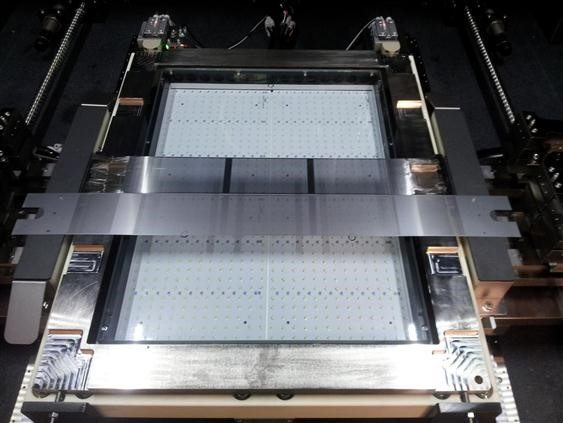
<Tianma, divided mask slot type>
Yi Choong-hoon /Chief Analyst / UBI Research / ubiyi@ubiresearch.co.kr
[Analyst Column] OLED 패널 후발 업체, 고해상도 마스크 확보가 사업 관건
/0 코멘트/카테고리: 애널리스트 칼럼 /작성자: oled중국 디스플레이 업체들이 OLED 패널 사업에 진입하기 위해 BOE를 선두로 Visionox, Tianma 등에서 OLED 패널 개발과 상품화를 준비하고 있다. 이들 후발 업체들이 선두 업체인 삼성디스플레이를 따라가기 위해서는 제품 성능과 가격이라는 두 마리 토끼를 동시에 쫓아야 한다.
OLED 패널 사업 선두 주자인 삼성디스플레이는 유리로 만들어지는 rigid type OLED는 독점 시장을 유지하고 있고, LG디스플레이는 모바일용 OLED 패널은 PI 기판을 사용하는plastic(flexible) OLED 패널만을 생산하고 있다.
모바일 기기의 해상도가 점차 고해상도화로 이동함에 따라 OLED 역시 QD급 해상도를 지원하는 OLED 패널이 생산되고 있으나 real 해상도가 아닌 pentile 방식을 사용하고 있다. 삼성디스플레이와 LG디스플레이는 OLED 업계에서 선두 주자들이기 때문에 supply chain 역시 매우 탄탄하게 구성되어 있다. 재료 업체들을 포함하여 장비와 부품 업체들까지 이들 2 기업들과는 매우 긴밀한 관계를 맺고 사업을 하고 있어 후발 업체들이 이들 업체들로부터 좋은 재료와 부품들을 공급 받기가 어렵다.
선발 업체들이 경쟁 업체들의 추격을 따돌리기 위한 전략으로서 자사에 공급하는 업체들이 경쟁 업체 또는 후발 업체들에게 제품을 공급하지 못하도록 산업 생태계를 철저히 관리하고 있다.이러한 선발 업체들의 전략에 의해 후발 업체들은 개발에 필요한 충분한 자원을 확보할 수 없다.
대표적인 부품이 고해상도에 필수적인 shadow mask이다. Fine metal mask라고 알려진 이mask는 RGB 구조의 고해상도 OLED를 생산하기 위한 필수 부품으로서, 특히 300ppi 이상의 고해상도 OLED를 만들기 위해서는 40um 정도의 박판으로 된 shadow mask가 필요하나 후발 업체들은 현재 이 mask를 제공해 줄 수 있는 업체를 찾기 어렵다.
BOE는 shadow mask 문제를 해결하기 위해 최근 WRGB 구조의 OLED 개발을 신중히 검토하고 있다. WRGB OLED는 발광재료를 적층하여 사용하는 구조이기 때문에 fine metal mask가 필요하지 않다. WRGB OLED는 white 광을 만들고 color filter를 통해 색상을 구현하는 방식이다.
Tianma에서는 shadow mask를 분할한 slot type mask를 개발 중에 있다.
<Tianma, divided mask slot type>
이충훈 / 수석 애널리스트 / 유비산업리서치 / ubiyi@ubiresearch.co.kr
LG전자, TV는 OLED 시대
/0 코멘트/카테고리: /작성자: oled지난 10월 14일부터 17일까지 개최된 한국전자전에 LG전자가 TV부터 스마트폰, 스마트 워치까지다양한 제품을 선보였다. 전시된 제품 중 단연 돋보이는 제품은 OLED TV와 최근 출시된 G Watch R이었다. LG전자 부스 입구에 77inch UHD curved OLED TV 5대를 파노라마 형식으로 전시하여 주목을 끌었으며, 출구에는 G Watch R 내부 화면을 나타내는 동그란 디스플레이와 함께 G Watch R을 전시하였다. 부스의 입구와 출구에 OLED를 탑재한 제품을 전시하여 LG전자가 현재 OLED를 바라보는 시각을 엿볼 수 있었다.
한 가지 LG전자가 한국전자전을 통해 달라진 점을 보였다. 바로 LG OLED TV에 대한 태도이다.
지난 9월에 독일 IFA2014에서는 많은 OLED TV를 전시했음에도 불구하고 OLED TV 대한 설명 밑에는 모두 “The Future of TV”(TV의 미래)라는 이름으로 OLED TV에 대해 소극적이 모습을 보였다. 하지만 한 달이 지난 한국전자전에서는 “이제 TV는 OLED 올레드 시대” 라는 문구를 부스 상단에 커다랗게 배치하고 77인치 UHD Curved OLED TV와 함께 배치함으로써 OLED TV에 대해 적극적인 모습으로 변화했음을 보여주었다.
LG전자가 OLED TV 시대를 넓혀가기 위해 넘어야 할 산들이 있을 것이다. 위 사진에서 LG전자가 직접 표시한 바와 같이 Curved UHD TV 또한 하나의 산일 것이다. 산을 넘고 “마침내 TV는OLED(올레드)시대”가 되기까지 LG전자가 어떠한 다음 액션을 취할지 기대된다.
Samsung VS. LG, to take different OLED strategies
/0 코멘트/카테고리: /작성자: OLEDNETThe separate OLED strategies of Samsung Electronics and LG Electronics drew much attention at the Korea Electronics Show 2014 held at Ilsan KINTEX from 14th October.
Samsung Electronics promoted the 105-inch bendable UHD TV with a curvature of 4000R as a major product and implied concentration on LED TV as not exhibiting OLED TV. Meanwhile, the Galaxy Note Edge and 4, and gear S were displayed intensely in the mobile section, suggesting that the mobile is taking the OLED oriented strategy.
On the other hand, LG Electronics received fervent response from the audience as exhibiting the five 77-inch Curved UHD OLED TV and advertised OLED TV providing customers to experience merits of OLED TV at the OLED TV zone set inside the booth. For mobile, only the G Watch R applying OLED was showed without any comment on the following product of G-flex.
This tendency of pursuing disparate strategies began from CES 2014 of this year. Starting from excluding OLED TV from the booth under the theme of World first curved UHD TV, Samsung has stated at IFA 2014 that the concentration is more on the LED not OLED in terms of TV for a while. With regard to mobile, active strategy was devised releasing the Galaxy 5, Galaxy note4, and Galaxy tap S with QHD AMOLED panel and Galaxy Edge with flexible display. LG lowered the price of the 55-inch Curved FHD OLED TV down to $4,000 and implemented dynamic promotion, announcing the release of 55-inch, 65-inch, and 77-inch curved OLED TV. And publicly mentioning the focus on the OLED TV business, LG has highlighted that it will lead the OLED TV market in the future.
<LG Electronics’ 77-inch curved UHD OLED TV와 OLED TV Exclusive Booth>
<Samsung Electronics’ 105-inch bendable UHD TV and mobile booth>
LED TV emits three times more harmful blue light than OLED TV
/0 코멘트/카테고리: 디스플레이, 디스플레이, 디스플레이, 디스플레이, 디스플레이, 디스플레이, 디스플레이, 디스플레이, 디스플레이, 디스플레이, 디스플레이, 디스플레이, 디스플레이, 디스플레이, 디스플레이, 디스플레이, 디스플레이, 디스플레이, 디스플레이, 디스플레이, 디스플레이, 디스플레이, 디스플레이, 디스플레이, 디스플레이, 디스플레이, 디스플레이, 디스플레이, 디스플레이, 디스플레이, 디스플레이, 디스플레이, 디스플레이 /작성자: OLEDNETThe LCD emits 3.1 times more blue light than OLED, said Choi Dong-won, senior vice president of LG Display at the IMID Display Business Forum held at Ilsan Kintex.
Recently, the harmful aspect of the blue light is suggested in Japan including Europe and U.S. The blue light emits the high-energy light of 380~550nm wavelength. In May of 2012, the Harvard Medical School has announced that the exposure to the blue light at night may keep people up late as well as cause cancer, diabetes, or heart disease, and there was a research regarding the influence of blue light from LED on retina at Japan.
LG Display said that OLED TV emitted 1/3 of blue light than LCD TV, measured under the general household environment.
Mr. Choi also said that the blue light issue will be resolved as the blue light is proportional to the luminance and area, and LG Display manufactures OLED panel for the use of TV changes from 55-inch to 65-inch. He also added that OLED TV is appropriate for Curved TV as it is, unlike LCD, free of light leakage phenomenon.
Samsung Display, OLED is the best for mobile devices
/0 코멘트/카테고리: /작성자: OLEDNETSamsung Display proved that the OLED is the optimum display for a mobile device as launching the new function which is only available in the OLED at the IMID 2014 held at Ilsan, KINTEX.
Samsung Display introduced the ultra-power saving, color weakness, and super dimming which are the functions maximizing the merits of AMOLED.
Ultra power saving mode is a function structuring the screen with black and white as a grayscale display by activating only the parts expressed in white using the OLED feature of operating pixels separately. This function is not offered by LCD which requires to run entire BLU for only one pixel and it is useful in emergency situation as it is possible to use the smartphone up to 8 days with the 63% of battery.
Color weakness mode is a function enabling people with color vision deficiency to distinguish R and G clearly through the display by applying the technology of increasing or reducing the brightness of R and G pixel among the R,G,B sub pixels of OLED and it is also not available in the LCD which uses color filter.
Lastly, super dimming mode is a function providing a comfortable viewing experience without any distortion or dazzle in very dark environments. In the bed room environment, 1~2 nit is reported to be the best nit without dazzle, and while there is a dazzle effect for LCD even in the lowest 8 nit in the bed room environment, there is glaring for OLED that 2 nit is possible, allowing people to watch comfortably.
In addition, announcing the 14-inch AMOLED panel for tablet PC with the resolution of WQUXG, Samsung Display drew a great interests from the audience, attesting Samsung Display’s exceptional technology in mobile AMOLED.
<Ultra Saving mode>
<Color Weakness mode>
<Super Dimming mode>
삼성디스플레이, mobile에서는 OLED가 최고
/0 코멘트/카테고리: /작성자: oled일산 킨텍스에서 열린IMID 2014에서 삼성디스플레이가OLED만이 구현할 수 있는 새로운 기능을 선보이며mobile에서는OLED가 최고의 디스플레이임을 입증하였다.
삼성디스플레이는 AMOLED의 장점을 극대화한 기능으로서 ultra power saving, color weakness, super dimming을 소개하였다.
Ultra power saving 모드는 흑백 모드처럼 블랙과 화이트로서 화면을 구성하는 기능으로서 화소를 개별적으로 구동하는 OLED의 장점을 살려 화이트로 표현되는 부분의 화소만 작동을 시킨다. 한 개의 화소만 구동하더라도 BLU 전체를 구현하는 LCD로서는 적용할 수 없는 기술로서63%의 battery에서 최대 8일까지 smartphone을 사용할 수 있어 긴급상황에서 유용하게 적용할 수 있다고 설명하였다.
Color weakness모드는 OLED 화소의 R,G,B sub pixel중 R과 G pixel의 휘도를 높이거나 줄이는 기술을 적용하여 색약자들이 display를 통해 R과G를 또렷이 구분 할 수 있는 기능으로서 역시 color filter를 이용한 LCD로서는 구현할 수 없는 기술이다.
마지막으로 super dimming모드는 어두운 환경에서 눈부심 없고 색의 왜곡이 없이 편안하게 화면을 볼 수 있는 기능이다. Bed room 환경에서는 1~2nit 가 눈부심이 없는 최적의 nit로 보고되고 있으며, LCD는 최저 8nit로서 bed room 환경에서 눈부심 현상이 있을 수 밖에 없지만 OLED는 최저 2nit가 가능하여 눈부심 없이 편안하게 화면을 바라볼 수 있다고 밝혔다.
또한 삼성디스플레이는 최초로 tablet PC용 14inch의 WQUXG 해상도의 AMOLED panel을 공개하여 관객들의 높은 관심을 모았으며, mobile AMOLED에서 삼성디스플레이의 뛰어난 기술력을 다시 한번 입증하였다.
<Ultra Saving mode>
<Color Weakness mode>
<Super Dimming mode>
Korean Display Companies, need urgent restructuring!
/0 코멘트/카테고리: /작성자: OLEDNETAs the sales of Korean display companies drop drastically, the business profits are under the serious situations.
In 2012 when Samsung Display was established, the sales was about 33 trillion won and 29.8 trillion won in 2013, reduced by 10%. And it is expected to be about 24 trillion won, decreased about 20% compared to the previous year. LG Display is undergoing the similar situation where the sales was 29.4 trillion won in 2012 and 27 trillion won in 2013, losing the amount of 2.4 trillion won. The prospected sales for 2014 is about 25~26 trillion won.
Samsung Display’s business profits recorded 3.2 trillion won in 2012 and 3 trillion won in 2013, but the profit of 2014 is not anticipated as it is only 140 billion won in the second quarter of the year. Meanwhile, the business profits of LG Display were 0.9 trillion won in 2012 and 1.2 trillion won in 2013, expecting 1.4 trillion won in 2014.
While the sales and business profits of Samsung Display are slumping, the LG Display is improving its business value as the business profit increases slightly despite the sales decrease.
But these companies are facing inevitable sales decrease due to the intense investments and panel cost reductions of Chinese display companies, and increase of the production costs, worsening sales conditions of Korean display companies. Moreover, it is even harder to secure competitiveness as the technology level of Chinese panel companies are getting closer to that of Korean companies.
The problem is the decrease in the business profit. In reality, Samsung Display maintains the 33,000 employees since 2012. Given that the sales has decreased by 30% from 33 trillion won to 24 trillion won, keeping the same number of employees implies chronic structure of restricting the improvement of business profit. In purely arithmetical terms, Samsung Display requires structural adjustment of about 10,000 employees. The situation is unfavorable with LG Display as well. LG Display has about 55,000 employees which is 20,000 more than Samsung Display. LG Display’s business profit for this year might be greater than that of Samsung Display but it is relatively in bad circumstances considering sales per individual.
There still is no element likely to appear in 2015 to enhance the sales and business profits more than 2014. The sales fall is expected as the price is continually decreasing without any additional investment, and there is a high probability of business profit drop. However, there is a chance to increase the sales and business profits if these companies secure a market for the expensive OLED panel.
For display companies, the only way to achieve business profits without restructuring is lowering the supply prices of the parts, materials, and equipment. The OLED material industry which is blossoming now is struck by the mortal blow of 50% decrease of OLED emitting materials and relevant materials compared to 2012. The price decrease range of materials is excessively severe compared to the price decrease of the panel. Some companies are reconsidering the business and the poor performances of those display companies are shaking the forward and backward linkages of the industries higher than the actual numerical value.
To save the entire Korean display industries, Samsung Display and LG Display must secure the sound financial structure through structural adjustments rather than requesting of cost reduction for the supplier unilaterally.
The collapses of Japanese companies resulted from retaining the employments in spite of sales aggravation must be taken as a lesson.
LED TV, 몸에 나쁜 청색 빛 OLED TV의 3배
/0 코멘트/카테고리: /작성자: oled일산 킨텍스에서 개최된 IMID 비즈니스 포럼을 통해 LG디스플레이 최동원 전무는 LCD에서 나오는 blue light가 OLED에 비해 3.1배가량 된다고 전했다.
최근 일본을 비롯한 유럽, 미국에서는 blue light의 해로움에 대한 주장이 나오고 있다. Blue light는 380~550nm 파장의 고에너지 빛을 말한다. 2012년 5월 Harvard Medical School에서는 늦은 밤 blue light에 노출되는 것은 불면증뿐만 아니라 암, 당뇨병, 심장병을 유발하는 원인이 될 수 있다고 발표했으며, 일본에서는 LED에서 나오는 blue light가 망막에 영향을 미친다는 연구가 이루어지기도 했다.
LG디스플레이는 일반 가정환경에서 LCD TV와 OLED TV를 측정한 결과, OLED TV에 나오는blue light는 LCD보다 1/3로 측정되었다고 말했다.
Blue light는 휘도와 면적에 비례하기 때문에 LG디스플레이가 생산하는 TV용 OLED 패널이55인치에서 65인치로 커지면서 blue light 문제도 나아질 것이라고 LG디스플레이 최전무는 전했다. 이 외에도 빛샘현상이 있는 LCD와 달리 빛샘현상에 자유로운 OLED TV가 Curved TV에 적합하다고 강조했다.
LG Chem., 런던의 레스토랑 Tincan에 OLED lighting panel 공급
/0 코멘트/카테고리: /작성자: OLEDNETLG Chem.의 OLED lighting에 대한 적극적인 마케팅 활동이 계속되고 있다. 지난 8월 IVAAIU 시티 플래닝과 함께 리모델링한 한옥에 OLED lighting panel을 적용하였고, 이태원의 Marley coffee라는 카페에도 240개의 OLED lighting panel을 이용하여 나비모양의 조명을 공급했다. 이어 지난 9월에 오픈한 런던의 pop-up 레스토랑 Tincan에 원형 OLED lighting panel을 공급하였다.
Tincan에 적용된 OLED 조명은 올해 초 LG Chem.에서 최초로 공개한 Φ100 OLED Light panel(N6OA30)이 사용되었다. Panel의 효율은 60lm/W, 최대 CRI는 90이상, 수명은 3,000cd/m2에서 40,000시간으로서, 두께는 1mm 밖에 되지 않는다. Lamp 디자인은 건축 디자인회사인 AL_A에서 디자인 하였으며 3D printing을 사용하여 제작되었다.
LG Chem.은 지난 9월, LED 조명에 버금가는 100lm/W와 40,000시간의 수명을 가진 OLED lighting panel을 11월 출시한다고 밝히는 등 가장 적극적으로 OLED lighting panel 사업을 진행 중에 있으며, Acuity와 Zumtobel등 다양한 조명 업체를 고객사로 확보하고 있다.
<Tincan에 설치된 LG Chem.의 OLED lighting panel>
LG Chem., provide OLED lighting panel illuminate Tincan, the restaurant in London
/0 코멘트/카테고리: /작성자: OLEDNETLG Chem. continues its intense marketing activities for the OLED lighting. The OLED lighting panels were applied inside the Hanoak (traditional Korean house), remodeled with the IVAAIU City Planning last August, and the butterflied shaped lightings applying 240 OLED lighting panels were supplied to the caf? called Marley coffee in Itaewon. And the circular type OLED lighting panels were used to decorate Tincan, a newly opened pop-up restaurant in London in last September.
The OLED light used as the light source at Tincan was the Φ100 OLED Light panel (N6OA30) that the LG Chem. introduced early this year for the first time. The efficacy of the panel is 60lm/W, a high CRI is over 90, and the lifetime is 40,000 hours (LT70) at 3,000 cd/m2, with only 1mm in thickness. The Lamp was designed by the architectural design firm AL_A using 3D printing.
LG Chem. is leading the OLED lighting panel business most actively as making the announcement last September for the release of the OLED lighting panel in November which will be equivalent to a LED lighting with the efficacy of 100lm/W and the lifetime of 40,000, and it has secured various lighting companies like Acuity and Zumtobel as a client.
< LG Chem.’s OLED lighting panel installed at Tincan>
삼성과 LG, 서로 다른 OLED 전략
/0 코멘트/카테고리: /작성자: oled14일부터 일산 킨텍스에서 개최된 한국전자전 2014에서 삼성전자와 LG전자의 서로 다른OLED 전략이 많은 관심을 끌었다.
삼성전자는 곡률반경 4000R의 105inch bendable UHD TV를 메인으로 내세운 반면에 OLED TV는 전시를 하지 않으며, 당분간 LED TV에 집중할 것임을 암시하였다. 반면 모바일 쪽에서는Galaxy Note Edge와 4, gear S를 집중적으로 전시하며 mobile은 OLED 중심의 전략임을 확인 할 수 있었다.
LG전자는 77inch Curved UHD OLED TV 5대를 메인으로 전시하여 관객들의 큰 호응을 얻었으며, 부스 내에 OLED TV존을 만들며 적극적으로 고객들에게 OLED TV의 장점을 부각시키는 전략으로서 OLED TV를 홍보하였다. 반면 mobile에서는 G-flex 후속작에 대한 내용은 없이 G Watch R만이 OLED가 적용된 제품으로서 전시되었다.
이 같은 양사의 서로 다른 전략은 올해 CES2014에서부터 시작되었다. 삼성은 World first curved UHD TV주제의 부스에 OLED TV를 제외시킨 것을 시작으로 IFA2014에서도 OLED TV에는 비중을 두지 않으며 TV에서는 OLED가 아닌 LED에 당분간 집중할 것임을 밝혔었다. 반면mobile에서는 QHD AMOLED panel을 적용한 Galaxy 5와 Galaxy note4, Galaxy tap S, flexible OLED를 적용한 Galaxy Edge의 다양한 제품을 출시하며 적극적인 전략을 펼쳤다. LG는 55inch Curved FHD OLED TV 가격을 $4,000 이하로 내렸으며, 55inch 65inch, 77inch curved OLED TV를 출시 할 것으로 밝히며 적극적인 마케팅을 펼쳤다. 또한 OLED TV 사업에 집중할 것임을 공식적으로 언급을 하여 앞으로의 OLED TV 시장을 리드할 것임 강조하였다.
<LG전자의 77inch curved <LG전자의 77inch curved UHD OLED TV와 OLED TV 전용 부스>
<삼성전자의 105inch bendable UHD TV와 mobile 부스>
Flexible AMOLED battle, Who are going to win?
/0 코멘트/카테고리: /작성자: OLEDNETIn 2013, the flexible AMOLED panel was mass produced in Korea for the first time in the world and the smart phone applying this technology was released. With the announcement of smart phones like Galaxy Gear and G watch R this year, the interest in flexible AMOLED industry is rising, developing actively in Korea, Japan, China and Taiwan.
As a front-runner, LG Display of Korea is mass producing the round type flexible AMOLED panel for G watch R along with the groundwork for the 5.5-inch flexible AMOLED panel to be employed on the G flex 2. In addition, the 18-inch flexible AMOLED panel was developed as a part of the national project. Samsung Display supplied 2-side 5.6-inch flexible AMOLED panel for Galaxy Note Edge and 2-inch flexible AMOLED panel for Gear S, and it is planning to mass produce foldable flexible AMOLED panel upon successful development.
The SEL’s research activities are most active in Japan. SEL drew a huge attention at SID 2014 as introducing the tri-foldable, book type, and 13.5-inch 4K flexible AMOLED panels using CAAS-OS backplane.
The Chinese companies BOE and New Vision Optoelectronics launched the flexible AMOLED panel at SID 2014, and as AUO showing the 5-inch flexible AMOLED panel and ITRI presenting the 6-inch foldable AMOLED panel at Touch Taiwan 2014, the companies of Taiwan also joined the development competition.
Accordingly, key companies are in the course of developing the flexible AMOLED panel but the TFT technology exclusively for the plastic substrate (high-resolution/Bezel, power consumption) must be developed intensively for the fabrication on the flexible device in bendable/foldable/rollable form. Furthermore, the technology to lower curvature and encapsulation technologies must be developed along with the miscellaneous flexible components and equipment design technologies.

< Flexible AMOLED panel unveiled in 2014>
Flexible AMOLED 전쟁, 앞으로의 승자는?
/0 코멘트/카테고리: /작성자: oled2013년 세계 최초로 flexible AMOLED panel 양산이 한국에서 시작되었으며, 이를 적용한smart phone이 출시되고, 뒤이어 올해에는 Galaxy Gear S와 G watch R등의 smart watch가 출시되어 flexible AMOLED 산업에 대한 관심이 높아지고 있다. 이에 따라 한국과 일본, 중국, 대만에서도 적극적으로 flexible AMOLED panel을 집중적으로 개발하고 있다.
선두주자로서 한국의 LG Display는 round type의 G watch R용 flexible AMOLED panel을 양산하고 있으며, G flex 2에 적용할 5.5inch flexible AMOLED panel도 준비 중에 있다. 또한 국책과제를 통해 18inch flexible AMOLED panel을 개발하였다. Samsung Display는 Galaxy Note Edge에 적용된 2side 5.6inch flexible AMOLED panel과 Gear S에 적용된 2inch flexible AMOLED panel을 공급하였으며, foldable flexible AMOLED panel 개발에 성공하여 양산을 계획하고 있다.
일본에서는 SEL의 연구개발 활동이 가장 활발하다. SEL은 SID2014에서 CAAS-OS backplane을 적용한 tri-foldable과 book type, 13.5inch 4K flexible AMOLED panel을 공개하며 큰 관심을 끌었었다.
중국에서도 SID 2014를 통해 BOE와 New Vision Optoelectronics에서 flexible AMOLED panel을 공개하였으며 대만에서는 Touch Taiwan 2014을 통해 AUO가 5inch flexible AMOLED panel을, ITRI가 6inch foldable AMOLED panel을 공개하며 flexible AMOLED panel 개발 경쟁에 가세하였다.
이처럼 주요 업체들이 flexible AMOLED panel을 적극적으로 개발하고 있지만Bendable/foldable/rollable 형태의 flexible device에 적용되기 위해서는 위해서는 plastic substrate 전용 TFT기술 (고해상도/Bezel, 소비전력)이 집중적으로 개발되어야 한다. 또한curvature를 낮추기 위한 기술과 encapsulation기술, 그밖에 flexible components와 기구설계 기술들도 함께 개발되어야 한다.
<2014년에 공개된 flexible AMOLED panel>
OLED lighting panel 수명, LED에 도달
/0 코멘트/카테고리: /작성자: OLEDNETOLED lighting panel의 수명이 LED(50,000시간 이상)와 비슷한 수준으로 향상되고 있다.
일본 NIKKEI에 따르면 Kaneka에서 수명 50,000시간의 OLED lighting panel을 개발했다고 보도했다. 8x8cm의 size에 1mm두께로서 일부 조명업체에 샘플출하를 시작하였고 개선된 Blue material을 적용하여 열화에 의한 색상 변화를 40%이하로 낮추었으며, 가격도 기존과 비슷한 수준이라고 밝혔다.
KANEKA는 연 2만장의 capa.로서 OLED lighting panel을 생산하고 있으며, Lighting fair 2013에서 50x50mm와 80x80mm size의 OLED lighting panel을 white와 yellow, red, green, blue의 다양한 색상의 panel을 적용한 제품들을 전시하였으며, 50x50mm panel은 약 4,000엔, 80x80mm panel은 약 6,000엔에 판매 중에 있다.
현재 시판중인 OLED lighting panel중 가장 높은 수명은 LG Chem.에서 판매되고 있는 100x100mm panel로서 80lm/W에 50,000시간이다.
한편 유비리서치에서 발간한 “2014 OLED lighting Report”에서는 OLED lighting panel 시장은 2015년부터 본격적으로 개화하기 시작하여 2020년에 약 US $ 4,700 million이 될 것으로 전망하고 있다.
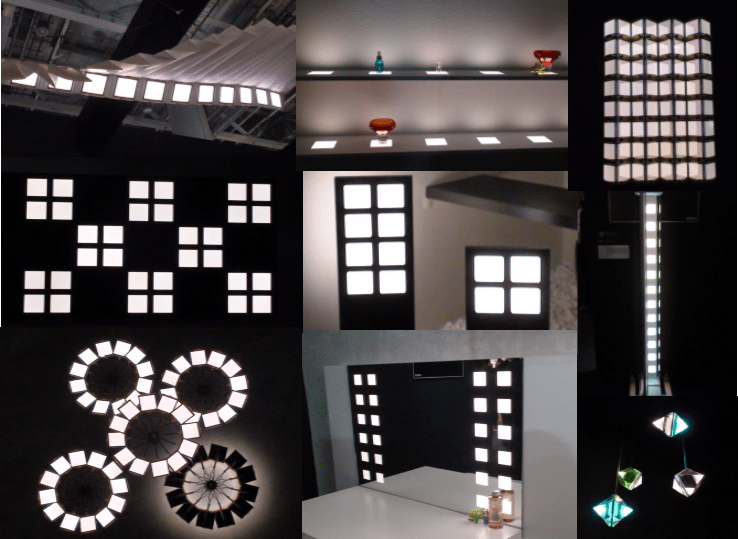
<Kaneka에서 공개한 OLED lighting 조명, Lighting fair 2013>
OLED TV, still the TV of the future?
/0 코멘트/카테고리: /작성자: OLEDNETTotal eight companies announced the OLED TVs at the IFA 2014. The size ranged from 55-inch to 77-inch and six among those eight companies exhibited UHD resolution OLED TV.
What these eight companies are implying through exhibiting the OLED TV is that it is the Future TV. Revealing the three UHD OLED TVs using LG Display’s 65inch UHD panel, Panasonic set off that it is the Next-Generation TV Technology and the Chinese company Changhong presented 55-inch and 65-inch Curved OLED TVs in the Changhong @ Future Display zone.
For the First in World Innovation Technology Zone demonstrating the future of the company, Samsung showed OLED TV with the phrase ‘Curved OLED TV’, underlining the word ‘Curved’ not ‘OLED’ and this indicates the company’s focus in other direction,Curved LED TV.
As the leading company of the OLED TV market, LG outdid the OLED TV exhibition with total 11 products of OLED TV from FHD to UHD Curved, and variables in different sizes. But LG also shared that the OLED TV is ‘The Future of TV’. It is contrasted against that OLED TV took more than 50% of the entire booth at IFA 2014 and the active involvement implemented to take over the OLED TV market.

[Future TV, OLED TV in IFA2014]
Then what is the current TV for LG? Why the future of a TV should be the OLED TV? First of all, it is due to the pricewise. The LCD TV of the same size and resolution is sold for the half price and even the consumers recognize no distinctive differences for purchasing the LCD TV.
Majority of the companies exhibited the OLED TV have manufactured the product using panels provided by the LG Display which is in the course of making constant efforts to open a full-scale OLED TV market. And numerous companies in related business expect LG to open a market for OLED. It is anticipated to see how LG the different TV maker will form the OLED TV market in the future.
OLED TV, 아직까지 미래의 TV인가?
/0 코멘트/카테고리: /작성자: oledIFA2014에서는 총 8개의 업체가 OLED TV를 공개했다. TV 크기는 55inch부터 77inch까지 전시가 되었으며, 8개 업체 중 6개의 업체가 UHD 해상도의 OLED TV를 전시하였다.
[IFA2014 OLED TV Exhibiting Companies]
한 가지, 8개의 업체가 OLED TV 전시를 통해서 나타내고 있는 점은 바로 Future TV라는 점이다. LG Display 65inch UHD panel을 사용한 전시한 Panasonic은 3대의 UHD OLED TV와 함께Next-Generation TV Technology(차세대 TV 기술)이라는 점을 나타내었으며, 중국 set 업체인Changhong은 Changhong @ Future Display zone에 55inch와 65inch Curved OLED TV를 전시하였다.
삼성은 자사의 미래를 나타내는 First in World Innovation Technology zone에 OLED TV를 전시하였으며, Curved OLED TV 문구 중 OLED 마크가 아닌 Curved를 강조해 현재 OLED 보다는Curved에 집중하고 있음을 나타내었다.
OLED TV 시장을 선도하는 기업답게 LG의 OLED TV 전시는 단연 돋보였다 FHD부터 UHD까지Curved, 가변형, 다양한 사이즈의 OLED TV 총 11대를 전시하였다. 하지만, LG 또한 OLED TV를 The Future of TV라고 표현했다. IFA2014에서도 전체부스의 50%이상 공간에 OLED TV를 전시했다는 점과 OLED TV 시장선점을 위해 보여줬던 적극적인 활동과는 대조적인 모습이라고 판단된다.
한 가지, 8개의 업체가 OLED TV 전시를 통해서 나타내고 있는 점은 바로 Future TV라는 점이다. LG Display 65inch UHD panel을 사용한 전시한 Panasonic은 3대의 UHD OLED TV와 함께Next-Generation TV Technology(차세대 TV 기술)이라는 점을 나타내었으며, 중국 set 업체인Changhong은 Changhong @ Future Display zone에 55inch와 65inch Curved OLED TV를 전시하였다.
삼성은 자사의 미래를 나타내는 First in World Innovation Technology zone에 OLED TV를 전시하였으며, Curved OLED TV 문구 중 OLED 마크가 아닌 Curved를 강조해 현재 OLED 보다는Curved에 집중하고 있음을 나타내었다.
OLED TV 시장을 선도하는 기업답게 LG의 OLED TV 전시는 단연 돋보였다 FHD부터 UHD까지Curved, 가변형, 다양한 사이즈의 OLED TV 총 11대를 전시하였다. 하지만, LG 또한 OLED TV를 The Future of TV라고 표현했다. IFA2014에서도 전체부스의 50%이상 공간에 OLED TV를 전시했다는 점과 OLED TV 시장선점을 위해 보여줬던 적극적인 활동과는 대조적인 모습이라고 판단된다.
[Future TV, OLED TV in IFA2014]
그렇다면 LG의 현재 TV는 무엇인가? 왜 OLED TV는 미래의 TV 일수밖에 없는가? 먼저 가격적인 측면이 있을 것이다. 동일한 사이즈와 해상도의 LCD TV는 50%의 가격으로 판매되고 있다. 또 소비자가 TV 구매 시, LCD TV와 큰 경쟁력을 느끼지 못한다는 점도 있을 것이다.
OLED TV를 전시한 업체 중 상당부분 LG Display가 공급한 panel을 이용해 OLED TV를 제작했다. LG Display는 본격적인 OLED TV 시장을 열기 위해 부단한 노력을 하고 있는 중이다. 또한 LG가 본격적인 시장을 열어주기를 바라는 OLED 관련 업체들도 상당하다. OLED TV 시장 형성을 위해 LG가 또한 다른 TV maker가 앞으로 어떤 모습을 보일지 주목되는 바이다.
한국 디스플레이 업체, 구조 조정 급하다!
/0 코멘트/카테고리: 시장 /작성자: oled한국 디스플레이 업체들의 매출이 급격하게 감소하며 더불어 영업 이익 또한 심각한 상황에 도달해 있다.
삼성디스플레이가 창립된 2012년 매출은 약33조원이었으나 2013년은 29.8조원 정도로 10% 가량 줄었으며, 올해는 전년 대비 20% 정도 감소한 24조 정도에 머물 것으로 예상된다. LG디스플레이 역시 2012년은 29.4조원이었으나 2013년은 27조원으로 2.4조원이 감소하였으며, 2014년 올해 매출은 25~26조원 정도일 것으로 추정되고 있다.
삼성디스플레이의 영업이익은 2012년과 2013년에 각각 3.2조원과 3조원이었으나 2014년은 2사분기까지가 1천4백억원에 불가하여 연말까지의 영업 이익은 기대되지 않는 상황이다. 이에 비해 LG디스플레이는 2012년에 0.9조원, 2013년은 1.2조원이며, 2014년 예상 이익은 1.4조원 정도이다.
삼성디스플레이는 매출과 영업이익이 급감하고 있는 상황이며, LG디스플레이는 매출은 감소하고 있으나 영업이익은 오히려 소폭 증가하고 있어 사업성이 개선되고 있는 것으로 보이고 있다.
그러나 이들 기업들의 매출 감소는 피할 수 없는 상황에 돌입해 있다. 중국 디스플레이 기업들의 공격적인 투자와 패널 가격 인하, 원가 상승에 따라 한국 패널 업체들의 영업 상황이 날로 악화되어 가고 있다. 더욱이 중국 패널 기업들의 기술 수준도 한국과 유사하여 경쟁력 확보가 갈수록 어려워지고 있다.
문제는 영업이익 감소이다. 실제로 삼성디스플레이는 2012년 이후 지금까지 직원수가 약3만3천명을 그대로 유지하고 있다. 2012년에 비하면 매출이 33조원에서 약 24조원으로 30% 감소하였으나 고용은 그대로 유지하고 있어 영업 이익이 개선될 수 없는 고질적인 구조이다. 산술적으로만 본다면 삼성디스플레이는 1만명 정도의 구조 조정이 필요하다. LG디스플레이 역시 좋은 상황은 아니다. LG디스플레이의 인력은 5만5천명 정도로서 삼성디스플레이에 비해 2만명 이상 많은 실정이다. 올해의 LG디스플레이 영업 이익은 삼성디스플레이에 비해 좋을 수 있으나 인원당 매출로 비교해 보면 삼성디스플레이에 비해 상대적으로 나쁜 구조이다.
2015년은 2014년보다 매출과 영업 이익이 나아질 요소가 아직 발견되지 않고 있다. 추가 투자가 없는 상황에서 가격은 지속적으로 하락되고 있어 매출 감소가 예상되고 있으며, 영업 이익 또한 감소될 가능성이 높아지고 있다. 물론 이들 업체들이 고가의 패널이 OLED 수요처를 확보한다면 매출과 영업이익이 급증할 수 있는 여지는 아직 남아있다.
디스플레이 업체들이 구조 조정 없이 영업 이익을 확보하기 위해서 할 수 있는 수단은 부품과 소재, 장비 업체들로부터 공급가를 인하 시키는 것이 유일한 방법이다. 현재 OLED용 발광재료와 관련 재료는 2012년에 비해 거의 50% 이하로 인하되어 있어 막 피어나는 OLED 재료 산업이 치명타를 입고 있다. 패널 가격 인하에 비해 재료 가격 인하 폭이 너무 심하다. 일부 업체들은 사업을 재검토해야 할 지경이라고 호소하고 있다. 디스플레이 업체들의 실적 악화는 실제 수치보다 몇 배나 높게 전후방 산업 자체를 흔들어 놓고 있다.
삼성디스플레이와 LG디스플레이가 한국 디스플레이 산업 전체를 살리기 위해서는 공급 업체들에 대한 일방적인 단가 인하 요청 보다는 먼저 자체 구조 조정을 통한 건전한 재무 구조를 확보해야 할 것이다.
일본 기업들이 매출이 악화되고 있음에도 고용을 유지하여 몰락한 것을 교훈 삼아야 한다.
What is the optimal encapsulation technology for the Flexible AMOLED?
/0 코멘트/카테고리: /작성자: OLEDNETCurrently mass-producing flexible AMOLED panels are taking PI substrate, backplane, and RGB deposition method, and the existing encapsulation technologies for A2 line of Samsung Display is TFE (thin film encapsulation) and hybrid encapsulation for LG Display.
But for the flexible AMOLED exclusive A3 line which is newly invested by the Samsung Display, advanced the orders not in the TFE but in the hybrid encapsulation method which is laminating the film after resin coating process on the passivation structure of inorganic layer and organic layer, similar to the method that the LG Display takes.
The reason for the change of encapsulation technology at the A3 of Samsung Display was analyzed in the “2014 Flexible OLED Report” issued by the UBI Research including the latest trends and issues such as the flexible AMOLED related issues and processes, market forecast of the flexible AMOLED panel and flexible OLED lighting, flexible AMOLED technologies comparison of Samsung Display and LG Display, etc.
According to this report, the flexible AMOLED panel market is forecasted to show a compound annual growth rate of about 60% through to 2020, reaching $ 17,600 million where the primary applications are expected to be for the flexible AMOLED panel of tablet pc.
<Flexible AMOLED panel Market Forecast>
Flexible AMOLED용 encapsulation, 최적의 기술은?
/0 코멘트/카테고리: /작성자: oled현재 양산중인 flexible AMOLED panel은 PI 기판과 LTPS backplane, RGB 증착방식을 적용하고 있으며, encapsulation 기술로서 Samsung Display의 A2 line에서는 TFE(thin film encapsulation)를 LG Display에서는 hybrid encapsulation을 적용하고 있다.
하지만 Samsung Display에서 신규 투자중인 flexible AMOLED 전용 A3 line에는 TFE가 아닌hybrid encapsulation으로서 발주가 진행되었다. Inorganic layer와 Organic layer적층의passivation 구조에 resin을 코팅한 후 film을 lamination 하는 방식으로서 LG Display와 비슷한 방식이다.
유비리서치에서 발간한 “2014 Flexible OLED Report” 에서는 Samsung Display가 A3에서encapsulation 기술을 변경한 이유에 대해 분석하였다. 그 밖에 flexible AMOLED 관련 이슈와 공정, flexible AMOLED panel 시장과 flexible OLED lighting 시장전망, Samsung Display와 LG Display의 flexible AMOLED 기술 비교 등 flexible AMOLED와 lighting관련 최신 동향과 이슈에 대해 다루고 있다.
본 보고서에 따르면 Flexible AMOLED panel 시장은 2020년까지 연평균 성장률 약 60%로서 성장하여 2020년에는 US $ 17,600 million의 시장을 형성할 것이며 주요 application은 tablet pc용 flexible AMOLED panel이 될 것으로 전망하고 있다.
<Flexible AMOLED panel 시장 전망>
LG전자, ‘울트라 올레드 TV’ 미국 출시
/0 코멘트/카테고리: /작성자: oledLG전자가 내달 ‘울트라 올레드 TV’를 미국 시장에 출시하며, 세계 최대 프리미엄 TV 시장 공략을 강화한다.LG전자는 17일(현지시간) 미국 뉴욕에 위치한 고담 홀(Gotham Hall)에서 ‘울트라 올레드 TV’ 출시 행사를 개최했다. 이날 행사에는 LG전자 미국 법인장 조주완 전무와 미국 유명 배우 케빈 스페이시(Kevin Spacey), 사라 제시카 파커(Sarah Jessica Parker), 닐 패트릭 해리스(Neil Patrick Harris)와 유명 디지털 아티스트 마크 트라이브(Mark Tribe) 등이 참석해 자리를 빛냈다.
이날 선보인 77형, 65형 ‘LG 울트라 올레드 TV’는 최고의 디스플레이와 최상의 해상도가 결합한 TV 기술의 집약체다. 이 제품은 WRGB방식의 울트라HD 해상도로 3,300만개의 화소가 마치 실물을 눈으로 보는 듯한 생생한 화질을 제공한다.
자체 발광 소자 특성상 무한대의 명암비와 완벽한 블랙 색상을 표현해 어두운 영역부터 밝은 영역까지 세밀하고 풍성한 색상 표현이 가능하다. 빠른 응답속도로 잔상 없는 자연스런 영상을 재현한다. 가격은 65형 제품이 9,999달러다.
LG전자는 이날 행사에서 ‘아트 오브 더 픽셀 (The Art of The Pixel)’ 공모전 결과도 발표했다. ‘아트 오브 더 픽셀’은 LG전자가 지난 6월부터 파슨스 디자인 스쿨, 프렛디자인 스쿨 등 미국 유수의 예술학교에 재학중인 학생들을 대상으로 진행한 디지털 예술작품 공모전이다.
이 공모전은 최첨단 디스플레이 기술과 예술의 만남을 테마로 기획됐으며, 디지털 아트 영역의 확대와 예술학도 양성이라는 의미도 지니고 있다. LG전자는 공모전 작품을 울트라 올레드 TV의 생생한 화질로 전시해 ‘화질의 LG’ 이미지를 확고히 했다.
LG전자는 ‘아트 오브 더 픽셀’ 공모전 대상 수상작인 ‘Painting from Life(일상을 그리다)’를 행사 현장에 있는 ‘울트라 올레드 TV’에 띄워, 참가자들이 최고의 해상도로 생생하게 즐길 수 있도록 했다.
이날 행사에 참석한 ‘닐 패트릭 해리스’는 “수채화를 스탑-모션 촬영 기법으로 표현한 대상 수상작이 인상 깊었다”라며 “수채물감의 선명한 색감이 ‘LG 울트라 올레드TV’를 만나 더 생동감 있게 표현됐다”라고 소감을 밝혔다.
LG전자 미국 법인장 조주완 전무는 “최고의 디스플레이와 최상의 해상도를 결합한 ‘울트라 올레드 TV’를 앞세워 세계 최대 프리미엄 시장인 북미 시장 공략을 강화할 것” 이라고 강조했다.
국문 풋터
OLEDNET의 모든 콘텐츠(영상, 기사, 사진)는 저작권법의 보호를 받은 바, 무단 전재, 복사, 배포 등을 금합니다. Copyright ⓒ 2013 by OLEDNET. All rights reserved.


